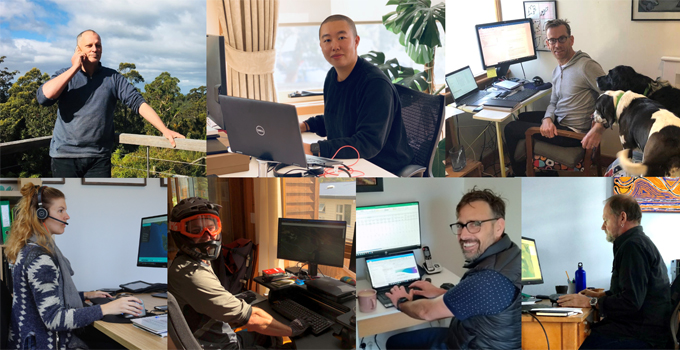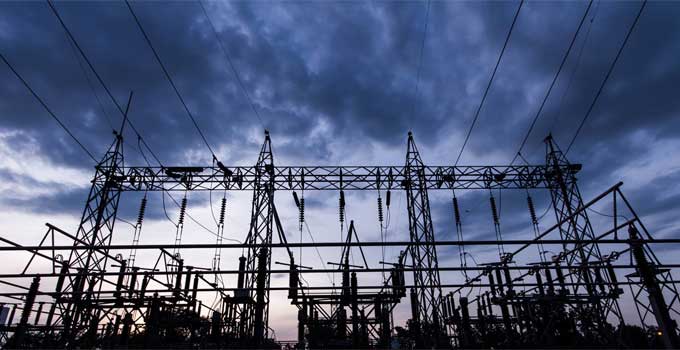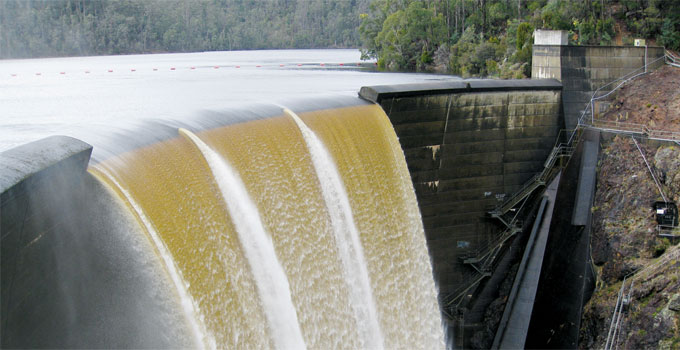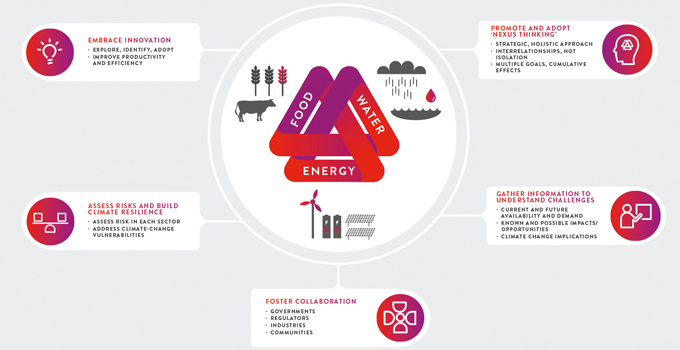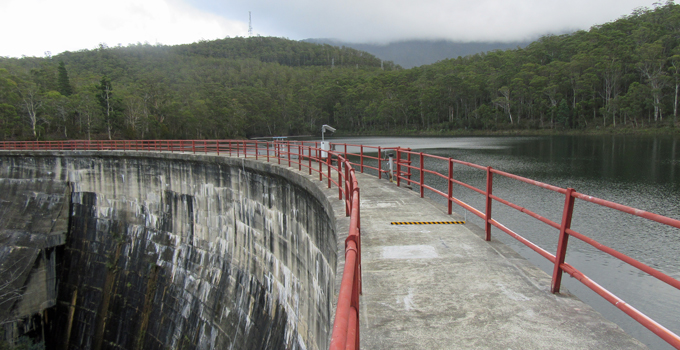When the lights go out
Major power outage events, like the one that affected Spain and Portugal this April, can be enormously disruptive and even deadly. Here Entura’s Technical Director Power, Donald Vaughan, considers the complex factors at play and their implications for grids everywhere ...

The recent power outage on the Iberian Peninsula provides a serious opportunity for reflection. Many articles have been published that try to explore the seconds and milliseconds after 12:32 PM on 28 April 2025 while only having access to the grainy frequency plots and approximate timelines that have been released (to date). This is not one of those articles. Nor is it an article that will lay blame on a particular technology or energy source. Instead, I will expand on the physics at play in this instance and reflect on whether current network security practices are adequately catering for changes to the power grid.
The physics
The power system is governed by the laws of physics, as is normal in the physical world. Quite a few of these laws tend to gang up on us during a power system event[1].
(i) conservation of energy
(ii) Ohm’s law
(iii) Newton’s laws of motion
and, of course,
(iv) Murphy’s law.
We’ll talk about the first three now and the last one later.
We learn very early that energy can neither be created nor destroyed (law i, above). This is at the heart of a power system event. The power system supplies loads by supporting voltage across the network that supplies millions of parallel loads. Each of these loads converts electrical energy into another form of energy based on the voltage it sees and its internal characteristics. This will continue as long as the voltage profile is maintained (law ii). So, demands take energy out of the power system regardless of what generation events occur.
We know that the main trouble in the recent Iberian event started when a large amount of generation stopped in southern Spain. This led to an imbalance between generation and demand in that region. That imbalance is immediately addressed through the inertial action of synchronous generation across Europe (law iii).
If interconnection were perfect, the burden of this inertial response would be shared perfectly across Europe and we probably wouldn’t be talking about this event quite as much as we are. Yet interconnection is rarely perfect (law ii). The frequency in Spain started to move away from frequency to the east and the AC interconnection to the east opened (which avoided the disturbance that stems from loss of synchronism). This should have been some help to the falling frequency in Spain given the eastward flows at the time. Under-frequency load shedding (UFLS) occurred around this time and should also have helped. It seems that the voltage disturbance that then occurred as a result of all these trips was the last straw.
Network security practices
It would be a gross over-simplification of network security practices to say that the power system should not lose customer load for the loss of one generation or network element (N-1 redundancy). The event on 28 April is way beyond that. Typically, for larger events, the grid should fail safely. We’ll look at that definition of ‘safely’ later. For now though, we can see that the grid did, in fact, try to fail gracefully:
- The AC interconnectors opened to avoid damaging loss of synchronism.
- The under-frequency load shedding operated to try to preserve supply to some customers and keep the grid up, so as to reduce the duration of the interruption.
- Other generating unit controls acted to either increase output or trip to avoid damage.
We see in the Iberian Peninsula outage, as we did in the major South Australian blackout in 2016, lots of independent protection operations slowly but surely weakening the grid to the extent that it is no longer viable. Each of these protection operations undergoes scrutiny after an event of this nature, and will likely lead to some changes in Spain and France as was the case in South Australia.
The 28 April event appears to be quite slow in comparison to some other network blackout events. Even so, the event lasted less than 20 seconds and had 2–3 stages within it. One of the bases of design of the AC network is that it can generally operate with minimal, fast coordination even under large events. Control relies on observation, computation and action. So, to manage an event, a control system must measure what it needs to reliably determine what control actions it must make, and then take those control actions (assuming it can control all the elements it might need to control) in time for them to have an effect. If we think about a need to deftly control the response of individual units (or control systems) in an unusual way in a short period of time, then we can quickly conclude that this may not be possible.
If we can’t manage these events in real time, we have three courses of action:
(i) Physical plant
We could design networks, network supports, and network and generator protection and control systems to be more robust in the face of large power system events, thus decreasing the likelihood of unnecessary cascading protection operation.
This would include better interconnection, more dynamic reactive support (separate from generating units and demand), system-level protection schemes, and a review of generating unit protection settings to ensure generator capability rather than network requirements setting operating limits
(ii) Dispatch rules
We could change dispatch to provide greater margin for real and reactive power control as determined by the security risk and the cost to mitigate it.
We could continue the traditional N-X approach to system supports or we could use a stochastic approach to determining system support requirements (weighting the probability of an event occurring against its impact). Either way, we’d have to pay an ‘insurance’ premium at each dispatch interval to make large-scale system outages less possible.
(iii) Restart planning and capability
We could make recovering from major blackout events easier and faster.
We think about these events in terms of how often they occur (which is what the first two course of action cover) and how long they last. System operators typically have generic plans for system restart that rely on starting synchronous plant and re-energising transmission systems and eventually customer demand. This can be made easier with interconnection. It can also be made easier with good visibility of voltages and voltage profiles across regions (and the tools to control them). Often, for big events like in South Australia in 2016, the network is left somewhat stricken from equipment damage. System restart efforts are often hampered in this scenario because plans need to be improvised to adapt. This depends on the skill, knowledge and experience of the operators. Some jurisdictions have simulated such events as part of training operators.
The fourth law
We know that ‘anything that can go wrong will go wrong’. Seemingly simple things can undermine the best laid plans and the best intentions. We often can’t plan for these things specifically, although HAZOPS, root-cause analyses, scenario simulations and reviews can help us understand where the problems may lie and give us a chance to close loop-holes before they become SNAFUs.
Major power outage events are serious. They often lead to loss of life or injury, and the recent Iberian Peninsula event was no exception. They also always have an economic impact, which is not always fairly distributed. As an industry we need to improve how we manage them. We also need to get better at talking about technical issues in a political environment. If there’s a risk of blackouts, we have a duty to not only mitigate that risk within the current rules but also advocate for rule changes if that mitigation is inadequate. To be most productive, this conversation should happen in a techno-economic environment. The automatic debate after power system events often focuses on the role of renewables, commercial interests and the like, which may sometimes be entertaining but inevitably affects the techno-economic outcomes in a negative way for everyone.
ABOUT THE AUTHOR
Donald Vaughan has over 20 years’ experience providing advice on regulatory and technical requirements for generators, substations and transmission systems. He has worked for all areas of the electrical industry, including generators, equipment suppliers, customers, NSPs and market operators. Donald specialises in the performance of power systems. His experience in generating units, governors and excitation systems provides a helpful perspective on how the physical electrical network behaves.
Image: Basil James on Unsplash
[1] There are more laws, but these are the main and most accessible.
Changing the climate future
The future isn’t what it used to be. The future we now expect is one of even more intense rainfall. What can we do about it?
In Australia, there is now expected to be a 41–88 % increase in intense rainfall assuming a fossil-fuel development emission scenario by 2090, working from a 1961–90 climate base. In Tasmania, our previous vision of 2090 was an expected intense rainfall increase of only 16.3 %. So the future is looking different, with more intense rainfall. New projections are making the present and near future look different too. We now understand that there will be a 16 % increase to the current climate (2021–40) for 3-hour-duration rainstorms (since the 1961–90 period). In other words, the ‘old future’ is now and the ‘new future’ is different from what we thought.
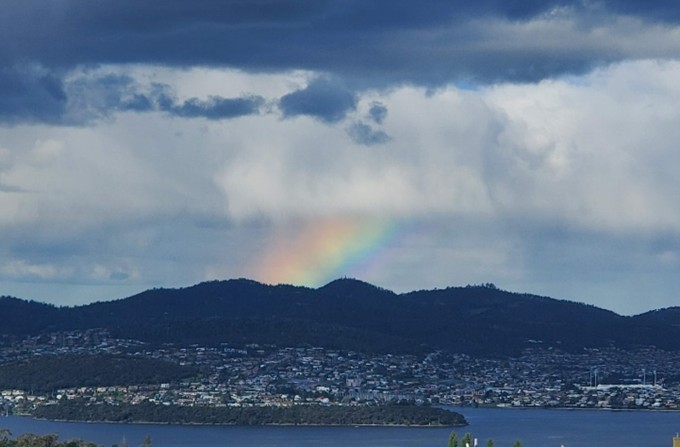
In December 2023, draft changes to the Australian Rainfall and Runoff (ARR) climate change advice were released, changing many of our projections. Between the 1961–90 rainfall data used to calculate the intensity-frequency-duration of most rainstorms and the ‘current’ climate (2021–40), there is expected to be a 1.3 °C rise in global temperature (noting that this comes on top of the already 0.3 °C increase in global temperature from the 1850–1900 pre-industrial period to 1961–90). So for a fossil-fuel development emissions scenario (SSP5–8.5, Meinshausen et al 2020), what we previously projected for intense rainfall by 2090 is now our projection for some storms in the ‘current’ climate (2021–40).
If the ‘old future’ is our new reality, what could the actual future be?
As of March 2024, the future is projected to be hotter than previously expected, and intense rainfall is expected to increase proportionally more for every degree of temperature rise. There could be a small increase in catchment losses, but these are expected to be overwhelmed by the increases in intense rainfall. There is also a better understanding of the uncertainty in the modelled projections.
An example in Tasmania
In Tasmania, water is fundamental for the environment and community, and the importance of our understanding of water is heightened by our reliance on hydropower for the bulk of our electricity. However, the climate changes discussed here are less about longer term water and energy yields than about the intense rainfall associated with flooding.
For Tasmania:
- Prior to the draft December 2023 ARR advice on climate change (Engineers Australia, 2023), with the SSP5 emission scenario with 8.5 W/m² radiative forcing there was projected to be a 16.3 % increase for all rainfall durations by 2090. The December 2023 draft advice for this scenario is that by 2090 the increase in intense rainfall is expected to be 41–88 % over the 1961–90 climate base (that is, the data you can get from the Bureau of Meteorology as the 2016 intensity-frequency-duration rainfall data). This means 41 % for 24-hour and longer duration rain storms, and up to 88 % for durations of 1 hour and shorter. These apply across Australia for rarities from an exceedance per year to the probable maximum precipitation event. There are several papers on the subject, for example Visser et al (2022) and Wasko et al (2024).
- For 1 hour and shorter duration storms, which are important for drainage from building roofs and for most town local stormwater systems, the current period (2021–40) has a 20 % increase in intense rainfall over the climate base (1961–90). This means that all designs made over the last few years using a 20 % increase in rainfall to allow for a future climate will still work as expected for the time being. But after about 2040, these designs are unlikely to perform as expected.
- For 3-hour-duration storms there is expected to be a 16 % increase over the climate base (1961–90) for the 1.3 °C rise in temperature to the ‘current’ period (2021–40). This means that what we thought would only happen in the more distant future is expected to be occurring now. The reasons we say this is ‘expected’ is that we won’t know for sure until we look back on this period with hindsight.
- For the 24 hour and longer durations, the current period (2021–40) has an 11 % increase in intense rainfall over the 1961–1990 climate base. With the non-linear relationship between rainfall and runoff, the increase in peak stream flood flow is expected to be higher than 11 % for most larger rivers, such as those that flow to our dams.
Impacts on decision-making and design
Following the Sixth Assessment Report in 2023 (AR6) by the United Nation’s Intergovernmental Panel on Climate Change (IPCC) (https://www.ipcc.ch/assessment-report/ar6/), and anticipating the next one due around 2029 – and with science and engineering understanding increasing all the time – it’s likely that our projections of the future scenarios and understanding of the past will continue to evolve. Obviously, infrastructure that’s built stays built, but can be augmented. Standards and methods can’t change every year for practical reasons, but those of us impacted by climate and water are wise to remain up to date and always use the most contemporary knowledge. Asset owners, regulators, consultants and the community need to pay attention as the climate changes.
When the goal posts shift, we need to take stock of previous advice provided with old rainfall data, and consider how to include current rainfall data in new advice. As we go forward, we also need to be more careful in our language about how we reference the past, current and future.
When making decisions for infrastructure that will last at least 100 years and take 5 to 20 years to plan, design and build, such as sizing dam spillways, a range of risk mitigation strategies are required for managing an uncertain future (for example https://entura.com.au/designing-dams-for-an-uncertain-climate-future/). When reviewing the performance of existing systems, defining the ‘current climate’ is important. Climate change isn’t something just for future scenarios – we’re living it now.
Strategies to support better climate-related decision-making include:
- using the current best knowledge
- understanding data and model uncertainty
- understanding natural climate variability on seasonal to decadal time scales
- understanding that future climate scenarios are all possible
- applying sensitivity analysis
- using multi-criteria assessment
- using staging strategies
- providing options in design for changing levels of service.
If, for example, we were designing a new building to be built soon near a watercourse, all the following approaches could be considered:
- Design the level of the earthworks and finished hardstand levels to meet the level of service in the ‘current’ climate (e.g. 2021–40), considering a freeboard over the raw modelled river levels to account for uncertainty in any modelled results.
- Make allowances in the construction to address future climate scenarios (e.g. SSP5 2090) and build now only what’s prudent.
- Allow space for a future flood wall and its footings, potentially building the footings now if integrated into the current site works.
- Consider space for future flood gates on site entry, and consider their storage and other requirements that are best allowed for in the current construction (such as communication and power conduits under hardstand areas, and space in control rooms).
- If a flood wall is not desirable or if construction access for building a flood wall is not going to be practical in the future once the site is developed, it may be better to lift the site levels or build the flood wall as part of the current works.
Uncertainty has always been part of engineering design, as has making decisions with imperfect knowledge. Climate systems in particular are subject to a wide range of natural variability over a wide range of times scales. What’s different now is that the future is more obviously uncertain and changing more rapidly. For example, where once we could use rainfall tables in textbooks for decades, now it seems that every few years there are new projections from the IPCC about large or small changes in our understanding. It’s a dynamic time for making decisions. But this isn’t all bad news.
Looking forward
If you’re planning an improvement project and the future is expected to bring larger floods, your return on investment may be quicker than expected. With the expected increases to rare rainfall intensities and the increasing uncertainty, there should be more confidence in investing in solutions to improve the performance of surface water infrastructure. In the same way, you’ll get a faster return on your investment in improving your engineering skills related to climate, hydrology and hydraulics of surface water systems and associated infrastructure design.
While considering the worst, we hope for the best. The fossil-fuel development emission scenario (SSP5) is based on us continuing the polluting hydrocarbon-based developments of the past. Entura is actively supporting our clients to pursue low emissions developments and more renewable energy for a better future. A best-case scenario is shown in the diagram below as SSP1 (called the sustainability scenario). In this scenario, with 2.6 W/m² radiative forcing, the projection for 2090 would be an increase of 1.7 °C in global temperature over the 1961–90 climate, and only a 14–27 % increase in intense rainfall (for 24 hour and longer to 1 hour and shorter durations respectively).
To prevent the extreme global temperatures projected to arise from polluting the atmosphere, it’s up to all of us to keep changing for a better future.

Figure of projected temperature increases associated with AR6 shared socioeconomic pathways relative to 1961–90 (shaded in grey) and their associated uncertainty (Engineers Australia, 2023)
References
Engineers Australia (2023) Update to the Climate Change Considerations chapter in Australia Rainfall and Runoff, Department of Climate Change, Energy, the Environment and Water https://storage.googleapis.com/files-au-climate/climate-au/p/prj2aec7b7ec59ab390bffc6/public_assets/Draft%20update%20to%20the%20Climate%20Change%20Considerations%20chapter.pdf.
Meinshausen et al. (2020). The shared socio-economic pathway (SSP) greenhouse gas concentrations and their extensions to 2500. Geoscientific Model Development, 13(8), 3571–3605. https://doi.org/10.5194/gmd-13-3571-2020.
Visser, Kim, Wasko, Nathan and Sharma (2022), The Impact of Climate Change on Operational Probable Maximum Precipitation Estimates, Water Resources Research, https://doi.org/10.1029/2022WR032247.
Wasko, Westra, Nathan, Pepler, Raupach, Dowdy, Johnson, Ho, McInnes, Jakob, Evans, Villarini and Fowler (2024), A systematic review of climate change science relevant to Australian design flood estimation, Hydrology and Earth System Sciences, https://doi.org/10.5194/hess-28-1251-2024.
If you’d like to talk with Entura about your water project, contact Phillip Ellerton.
About the author
Dr Colin Terry is a civil engineer at Entura with three decades of experience in Australia and New Zealand. His experience includes modelling, planning, design and construction support. He has worked on multidisciplinary projects across various parts of the water cycle including catchment management, water supply, hydropower, land development, transport, and water quality in natural systems – with a focus on surface and piped water.
MORE THOUGHT LEADERSHIP ARTICLES
Designing dams for an uncertain climate future
Dams are critical infrastructure for water supply, irrigation, energy production, flood protection, or multiple purposes. They are usually designed to last at least 100 years, yet with good maintenance and appropriate dam safety practices, dams can continue to perform as designed for centuries. But what about climate change? The circumstances in which a dam operates may be very different in the coming decades – and exactly how these changes will play out in different regions is impossible to predict with certainty.
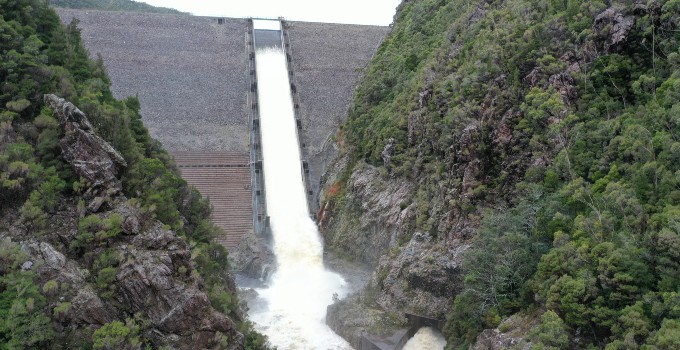
Dams are designed to continue to perform safely in extreme events, such as major floods and earthquakes, to avoid the high economic, environmental, and social consequences of dam failure. When the consequence has the potential to be extreme, the flood that the dam will need to be designed for is, in Australia, the ‘Probable Maximum Flood’ (PMF), while in some other parts of the world it is often the 1:10,000 annual exceedance probability (AEP) flood.
But even if standards or guidelines are clear about the ‘return period’ of flood that the dam should be designed for – is it still as simple as reading the magnitude of the flood discharge off the flood frequency curve as has been done in the past? These days, it is not so simple.
Exploring the inherent uncertainty in the flood frequency curve
Part of the reason for more complexity is that we have greater computing power today to be able to explore the uncertainty in our flood frequency curve. Predicting extreme flood events (such as the PMF) is not an exact science and involves many variables which are often not well characterised. As a result, there is significant uncertainty in predicting floods, particularly extreme floods. If this uncertainty is presented, the flood frequency curve is no longer a single line but a band. The more extreme the flood event, the wider the uncertainty band. Although the flood frequency curve shown below is fitted directly to measured flow data, the uncertainty bounds are similar regardless of the approaches implemented to derive the flood frequency curves.

So, what flood should the dam be designed for? Should it be the median best estimate, or should it take into account some of the uncertainty? This is the first challenge, and it is there whether we consider climate change or not.
Adding the extra uncertainty of climate change
Climate change doesn’t stand still. This adds even more complexity to the flood prediction challenge. What is the impact of climate change on extreme events now, and what will it be as time goes by? Numerous studies of climate change impacts suggest that there will be greater variability in extreme temperatures and extreme rainfall, and that extreme events may become more frequent. As a result, the magnitude of extreme flood events, for which dams must be designed, will likely increase with time.
Changes in the magnitude or frequency of extreme floods will depend on projections of future temperature, emission scenarios and the models used to simulate the changes. Even with a ‘middle of the road’ emission scenario (such as the IPCC’s SSP2–4.5 scenario) that results in a median global temperature increase of 3 °C (compared to preindustrial temperature baseline) by the end of this century, there could be a 23% increase in 24-hour extreme rainfall depth. But this is only one of the scenarios; some are more extreme, some show less increase, some show more. The increase is greater for higher emission scenarios and for shorter duration storms. Ultimately, an increase in rainfall depths results in an increase in flood magnitudes.
Guidance on climate uncertainty in dam design is limited
Currently, most standards and guidance documents are silent on how climate change should be applied in the design of spillway capacities for dams to safely pass these extreme flood events. However, the International Commission on Large Dams (ICOLD) Bulletin 142 on the Safe Passage of Extreme Floods (2012) indicates that there is uncertainty associated with the resulting flood estimates because of uncertainties in the hydrometeorological data used in determining the design flood. In addition, there may be changes in future methods for the development of design floods, changes in the future condition of the catchment (e.g. due to deforestation), and changes in rainfall conditions due to climate change. All of these have the potential to increase the magnitude of the future design flood.
This 2012 bulletin encourages strategies for planning spillway arrangements with consideration of floods exceeding the design flood (i.e. checking the robustness of the spillway flood design capacity from a dam safety risk perspective). This demonstrates that more than a decade ago the international dam engineering community was already promoting consideration of climate change resilience when designing new dams and upgrades of existing dams.
The more recent ICOLD Bulletin 170 on Flood Evaluation and Dam Safety (2018) states that although projected changes in climate are generally expected to increase flood risk in many parts of the world, understanding the impact on flood risk is subject to considerable uncertainty. It states that one of the main impacts of climate change will be to increase the uncertainty associated with the estimation of extreme floods.
There are tools available now that can be used to look at climate change impacts on extreme rainfall events, mainly around changing rainfall inputs to rainfall–runoff models based on climate advice, or else through using stochastic climate generators. However, this 2018 ICOLD bulletin also warns about complex numerical modelling and the ‘black box effect’ of accepting results without verification or critical consideration. It stresses that the intrinsic hydrological uncertainty will always remain no matter how clever or complex the numerical modelling.
Practical suggestions for dealing with uncertainty
Given that dams are designed for the long-term, it is crucial to consider the uncertainty of floods and the potential impacts of climate change. Climate impacts are being discussed increasingly by dam owners, dam engineers and dam regulators – and guidance on how best to deal with climate change will come eventually. This review article, ‘Climate change impacts on dam safety’, provides a good summary and some thoughts about approaching the issues in a framework based on dam safety risk.
In the meanwhile, we’ve developed some practical suggestions for dealing with intrinsic hydrological uncertainty and the increased uncertainty due to climate change, whether you’re working on new dams or upgrades to existing dams:
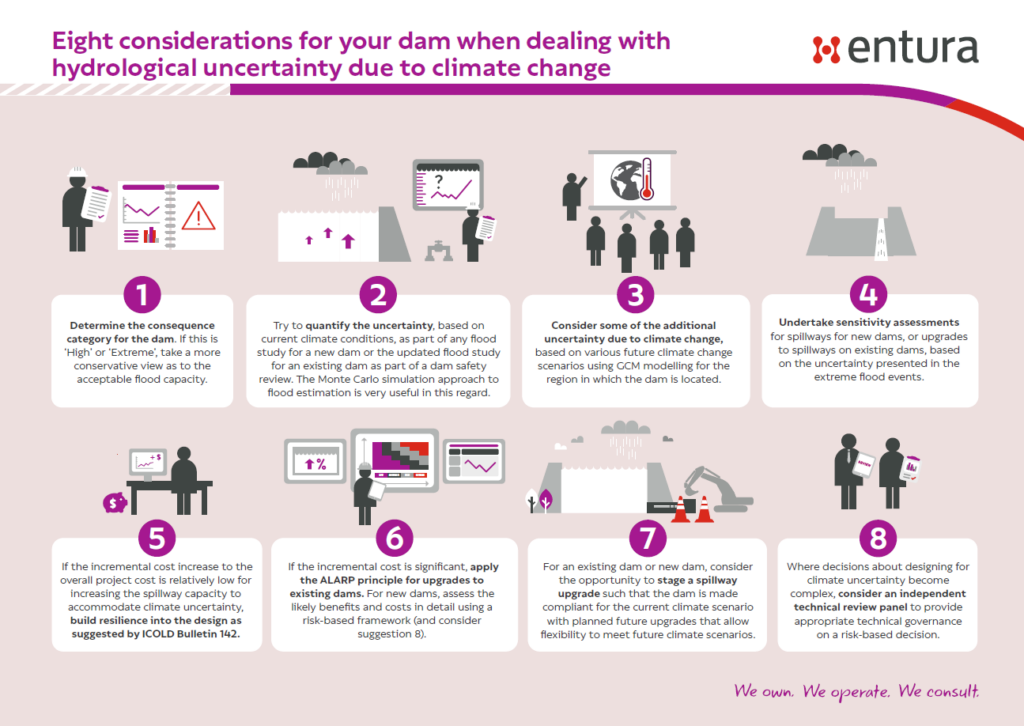
- 1. Determine the consequence category for the dam. If this is ‘High’ or ‘Extreme’, take a more conservative view as to the acceptable flood capacity.
- 2. Try to quantify the uncertainty, based on current climate conditions, as part of any flood study for a new dam or the updated flood study for an existing dam as part of a dam safety review. The Monte Carlo simulation approach to flood estimation is very useful in this regard.
- 3. Consider some of the additional uncertainty due to climate change, based on various future climate change scenarios using GCM modelling for the region in which the dam is located.
- 4. Undertake sensitivity assessments for spillways for new dams, or upgrades to spillways on existing dams, based on the uncertainty presented in the extreme flood events.
- 5. If the incremental cost increase to the overall project cost is relatively low for increasing the spillway capacity to accommodate climate uncertainty, build resilience into the design as suggested by ICOLD Bulletin 142.
- 6. If the incremental cost is significant, apply the ALARP principle for upgrades to existing dams. For new dams, assess the likely benefits and costs in detail using a risk-based framework (and consider suggestion 8 below).
- 7. For an existing dam or new dam, consider the opportunity to stage a spillway upgrade such that the dam is made compliant for the current climate scenario with planned future upgrades that allow flexibility to meet future climate scenarios.
- 8. Where decisions about designing for climate uncertainty become complex, consider an independent technical review panel to provide appropriate technical governance on a risk-based decision.
If you would like to speak with us about how climate change could affect your new or existing dam, please contact Richard Herweynen or Prafulla Pokhrel.
About the author
Richard Herweynen acknowledges the input of his colleagues Prafulla Pokhrel (Principal Consultant, Hydrology) and Paul Southcott (Senior Principal, Dams and Headworks) in writing this article.
Richard is Entura’s Technical Director, Water. He has more than three decades of experience in dam and hydropower engineering, and has worked throughout the Indo-Pacific region on both dam and hydropower projects, covering all aspects including investigations, feasibility studies, detailed design, construction liaison, operation and maintenance and risk assessment for both new and existing projects. Richard has been part of a number of recent expert review panels for major water projects. He participated in the ANCOLD working group for concrete gravity dams and was the Chairman of the ICOLD technical committee on engineering activities in the planning process for water resources projects. Richard has won many engineering excellence and innovation awards (including Engineers Australia’s Professional Engineer of the Year 2012 – Tasmanian Division), and has published more than 30 technical papers on dam engineering.
MORE THOUGHT LEADERSHIP ARTICLES
How robust is your emergency preparedness?

The old adage of ‘a company’s greatest assets are its people’ is never more true than in an emergency situation. The success of any emergency plan depends upon the skills, training and willingness of the people involved. It also relies on robust emergency preparation that takes as many scenarios as possible into account, and builds in a range of backups and alternatives for maximum agility and resilience.
All responsible dam owners have dam safety emergency plans (DSEP) which are carefully created and tailored to the needs of the company, its assets and its available resources.
If called upon in an extreme event, these plans will likely be pushed to their limit – but it’s vital that they perform as intended to reduce risk and consequences downstream.
The ultimate test of the emergency plan is how well it can cope with outages of power and/or communications. ‘Stress testing’ emergency plans for outage scenarios and implications is key to achieving a robust plan.
Power and communications outages
Where dams have moving parts, such as valves or floodgates, backups are needed to counter power outages. Are backup generators in place, or can a portable generator be brought to site at short notice? Is there a clear, safe access route to site during emergency conditions (e.g. not flooded or blocked by fallen trees)? Where this is not possible, can the valves or floodgates be operated by hand? A further question is whether these components are readily operable and exercised regularly.
Many dams are located in remote areas, and in some cases mobile phone reception is unreliable. In these situations, can satellite phones be made available? Landline phones may be available but depend on poles and lines remaining intact and operable during emergency conditions.
Communications are vital to ensuring the emergency plans are enacted under the direction of the incident controller. Where communications with remote resources are limited or not possible, those involved must fall back on their training and on lessons learnt from exercises and site-based, staged events involving scenarios of outages of power and communications. The DSEP can be updated with suggested actions for the on-site operators and emergency management team to follow in the worst-case scenario.
Alternative means of communication and access
In situations where check-in communications are required with those working remotely, alternative means must be considered in case of an outage of communications. In the absence of satellite phones, this could involve a messenger driving to site, but this relies on clear, safe access routes and careful consideration of the time required. In extreme cases, the only means of reaching a remote site may be by helicopter. This would require pre-arrangement with the closest helicopter providers regarding emergency availability.
The situation is similar with suppliers of plant and materials that may be required to assist with conditions at or downstream of the dam. How can they be contacted, and is there clear, safe access to site? Consider having emergency stockpiles at site or nearby and ready access to earthmoving plant.
Decision-making in a SCADA outage
If a power outage results in a localised SCADA outage, there will be no current instrumentation data available to guide critical decisions. In such circumstances, decisions must be based on likely behaviour during emergency conditions or on forecasts from before the emergency is declared. This would likely require detailed knowledge of the dams and their components, which highlights the importance of regular routine monitoring and detailed studies such as comprehensive surveillance reviews and dam safety reviews.
Company culture, teamwork and support
Where there is a ‘no blame’ company culture in which employees are encouraged to speak up, point out flaws in systems and processes and identify faults with assets, there is a greater likelihood that employees will participate successfully in staged exercises and events and provide useful information regarding how an incident response team will perform during an emergency.
Another important aspect of company culture is working together as a team. It is possible that a person may become fatigued but cannot convey this due to a communications outage. It is also conceivable that during an emergency a person may be unwilling to ‘leave their post’ until the job is done, becoming fatigued in the process.
It is important to have backup resources and to limit time in any role during the emergency to minimise the chance of mistakes being made. The emergency plan is only as strong as the weakest link in the chain of command.
For all resources, including external resources, provision of backups should take into account leave, prolonged illness and the need to ensure replacement when employees leave the company.
Where a company has a strong and positive safety culture and team ethos, detailed knowledge of its assets, regular inspection and exercising of valves and gates, and a commitment to team-based emergency training, employees are more likely to overcome the challenges posed by outages of power and communications during emergency conditions. They will find a way.
No one can predict and plan for every emergency scenario, but we believe that the tips we’ve shared here can help dam owners to develop and maintain robust emergency plans that have a higher likelihood of success when called into action.
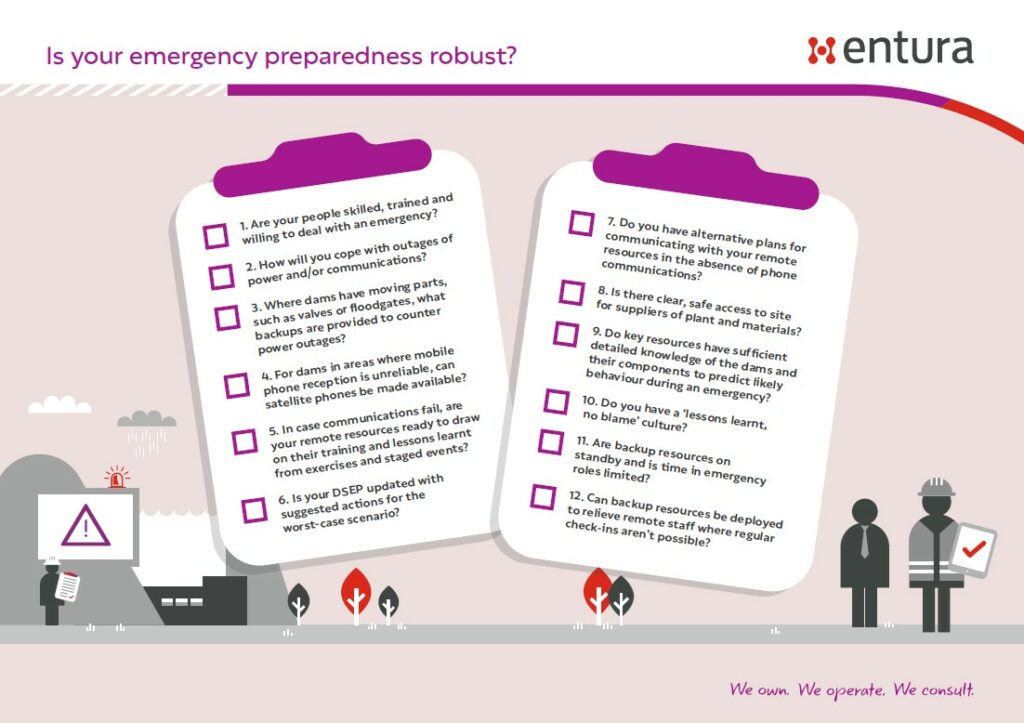
If you would like support with your emergency planning, contact Richard Herweynen or Phillip Ellerton.
About the author
Jamie Cowan is a senior dams engineer at Entura with over 2 decades of civil engineering experience in the UK and Australia. His experience includes the management of investigation, design and construction projects in the civil, dams and water industries. He has worked across all stages of project delivery, from feasibility to the commissioning of assets. He has provided construction support roles during dam construction and upgrade projects, and conducted intermediate and comprehensive inspections of dams for water authorities in Victoria.
MORE THOUGHT LEADERSHIP ARTICLES
New circumstances, new projects, new regulations
It’s a major challenge to keep an existing local project running during these tricky times (let alone an interstate or international project!), but how can we start new projects as the ground shifts around us and as regulations around Australia change?
In this third article from Entura’s environment and planning team, we feature a recent win in the national water infrastructure space – the detailed design, and planning and environmental approvals for a new off-creek storage in the Northern Tablelands of New South Wales. And we take a look at how regulatory changes are playing out around Australia to provide greater flexibility to respond to current constraints.
Starting a new project during a pandemic
Entura, working together with Hunter H2O, is now assisting Walcha Council with a regionally significant project despite COVID-19. The township of Walcha is currently serviced by one small off-creek water storage, which means that stringent water restrictions are needed during periods of drought. The regional council, supported by federal government funding, is investing in improving Walcha’s water reliability and security, which will also deliver social benefits to the community.
Our team tendered successfully when COVID-19 was yet to hit our shores, but in a mere few weeks we found ourselves loading up our office gear to set up from home. The same week that our engineering, planning and environmental specialists were scheduled to fly to Walcha to meet with Council on site, travel restrictions intensified and flying out of Tasmania was no longer an option. We adapted by taking to virtual platforms to communicate with our client about the challenges imposed by COVID-19 and how we could still keep the project moving, albeit with some deviations from the original schedule.
As a multidisciplinary firm capable of working across many jurisdictions, we pride ourselves on the relationships we have established with local contractors. In these times we are even more aware of the benefit of these associations to help keep the work flowing. For this project, collaboration with local contractors and swift adaptation has allowed the team to keep the project moving forward. Local geotechnical contractors have begun their investigations to feed information to our teams. Meanwhile, our environmental and planning experts have studied databases and existing literature to determine potential terrestrial, aquatic and regulatory constraints that may affect the design of the new off-creek storage.
Lockdown restrictions are starting to ease across the nation, but for now we are sitting tight and waiting until it is safe to visit the site. We need to ensure that storage design works are undertaken only when our technical specialists have stepped foot on the site themselves and have a thorough understanding of the site context. In the meantime, we continue to provide value through virtual meetings and workshops with our client. Hunter H2O and Walcha Council share our view regarding both the safety of our people and the quality of design required for the project.
On this constantly shifting ground, we are keeping the regulators up to date with the progress of the project, and we are also ensuring we keep up to date with any regulatory changes which may affect the project and that these are well-communicated with our client.
Regulatory changes for flexible responses
Across the country, state governments are establishing new measures to accelerate projects to shovel-readiness to help buffer the social and economic impacts of the pandemic. They’re also making temporary orders to existing legislation to provide flexible planning and environmental responses.
New South Wales
In New South Wales, the Planning System Acceleration Program has been introduced to fast-track State Significant Developments, rezonings and development applications, as well as provide support to decision-makers to speed up local and regionally significant projects to approval. Temporary orders have been implemented to allow some infrastructure construction work to be carried out on weekends to maintain productivity and employment in the sector. In NSW, temporary changes to the Environmental Protection and Assessment Act 1979 (EP&A Act) allows the Minister for Planning and Public Spaces to authorise development to be carried out on land without any approval under the EP&A Act where that development is required to protect the health, safety and welfare of the public during the COVID-19 pandemic.
Other recent legislative change in NSW is the long-awaited amendment of the NSW Bilateral Agreement under the Commonwealth Environment Protection and Biodiversity Conservation Act 1999 (Cmwth), which was required after the introduction of the new Biodiversity Conservation Act 2016 (NSW). This updated bilateral agreement has allowed environmental assessments and offsets to be streamlined, including endorsement of the NSW Biodiversity Offsets Scheme for the purposes of offsetting for a Commonwealth approval.
Queensland and Western Australia
In Queensland, COVID-19 has been declared an applicable event under planning legislation, thus allowing the Planning Minister more flexibility to suspend or extend any statutory timeframe across the planning framework if required. Similarly, in Western Australia, the Minister for Planning has issued a two-year extension for all current development approvals to assist job-creating projects during the recovery stage, along with other exemptions from planning approval for essential local community services.
Victoria
The Victorian Government has announced temporary measures to make sure that planning and approval processes can continue to function despite remote working arrangements, including allowing local government planning authorities to make decisions under delegation to facilitate efficient application turnaround times. The Victorian Government has also established the Building Victoria’s Recovery Taskforce to explore planning and investment opportunities to boost the development industry. Additionally, the new Victorian Environment Protection Amendment Act 2018 (EPA Act), which is relevant to many infrastructure projects, was to take effect from 1 July 2020 but has been deferred until July 2021 to ensure developers, consultants and regulators have time to adapt to changes in workload and workflow as a result of the pandemic.
Tasmania
Tasmanian planning reform continues with the exhibition and assessment of local planning schedules as part of the transition to a statewide planning scheme. Consultation has also concluded on the proposed process for major projects, which, if enacted, will be the state’s first multi-permit approval process.
Nationwide
The Commonwealth Environment Protection and Biodiversity Conservation Act 1999 is also currently being reviewed, and our planning and environmental consultants are ensuring that they keep pace with the impending changes and implications for ongoing and new projects.
Managing change
For the Walcha project, the approval process is comparatively simple and the changes to approval processes are not likely to impact the project. However, for some of our other projects, these changes create challenges. Most notably, physical distancing requirements have meant temporary shutting of council offices and town information centres where application documents and technical studies are usually displayed. Instead, full suites of application documentation are being published online or, when specifically required, hardcopies are being mailed out. With postal services already under pressure, one way to ensure the community has a fair opportunity to provide feedback is to lengthen comment and consultation timeframes.
Although the global pandemic may have been disruptive to our work arrangements, smart and innovative ways to juggle project commitments and changed circumstances have fostered strong relationships which will persist beyond COVID-19. Elevated levels of trust and virtual teamwork with clients will surely present more opportunities to collaborate once the ground settles and we reach a new equilibrium.
If you would like to discuss how Entura can help you with your environmental or planning project, please contact us.
MORE THOUGHT LEADERSHIP ARTICLES
Keeping international projects moving, even when we’re grounded
With no set date for when life will return to usual after COVID-19, nor any guarantee of whether life will ever return to what we previously knew as ‘usual’ at all, there are very few areas in the consulting life in which we can simply say ‘we’ll wait until this is all over’. Life, and projects, must go on.
Although we can’t avoid the disruption and uncertainty that the coronavirus has unleashed, we can increase our resilience and agility. We can also embrace opportunities to innovate and to create new ways (or reinvigorate old ways) to achieve our goals.
Here, Entura’s Environment and Planning team continue to apply their proactive approach to keeping projects alive in the current circumstances, and explain how they are continuing their activities on two international projects despite the travel restrictions that are making it impossible to visit the project sites.
Old ways for new times – Engaging communities in Tonga
For many countries across the globe, the immediate challenge is building resilience to fight through the pandemic. However, for some small island nations that have managed to stay out of the virus’s path so far, such as Tonga and the Federated States of Micronesia, the concept of resilience has a broader context.
Climate resilience is a core objective, as these nations are feeling the increasing impacts of rising sea levels and more frequent and intense weather events. In this context, robust power infrastructure that is suited to extreme weather is one component of greater resilience, as is transitioning from diesel dependence to higher levels of renewables, which builds greater security of energy supply at a lower longer term financial and environmental cost. More access to stable, reliable and clean electricity is also critical for the health, wellbeing and education of local communities, and is the foundation for economic development. Entura has been fortunate to be involved in some meaningful resilience-building projects in the Pacific, supporting many of our neighbouring nations to implement sustainable energy solutions.
However, with a current project in Tonga, coronavirus has thrown our travel plans into disarray. The challenge we’re facing now is how to continue the planning, engagement and environmental activities required by such a project when we can’t physically get there, can’t hold town hall meetings and can’t host information sessions with locals.
While the pandemic is forcing many practitioners to extend and expand their use of digital forms of engagement (such as websites, Facebook, Twitter, ‘Bang the Table’ or moderated ZOOM-based focus groups), some projects are located in communities that do not enjoy easily available or reliable internet or telephone access. In these cases, such as our project in Tonga, we need to think differently about ways to facilitate engagement from a distance.
For the Tongan project, we’re heading back to basics: the tried and tested solution of providing information on paper. Working with the local project management unit, along with our client, we are designing and implementing a newsletter to be printed in the local language and distributed to regulators and communities. It will provide snapshots of the project, latest updates on scheduling, and will even feature some interviews to provide greater coverage of ongoing community engagement.
As the construction company for the project is, like us, unable to travel internationally at the moment, construction is yet to take place. Nevertheless, we are continuing to facilitate all aspects of the project remotely, such as lining up approvals with regulators, and guiding engagement on the ground. With the help of our Tongan counterparts, we can still keep information and updates flowing despite the physical limitations on our involvement ‘in the flesh’.
Buying time and building partnerships in South-East Asia
Just as COVID-19 started closing borders and halting international travel, our team was reaching the culmination of many weeks planning an impact assessment for a large infrastructure project in South-East Asia. Our discipline experts were about to book their tickets and embark on the journey to site to survey environmental and social impacts. However, we placed the site surveys on hold indefinitely to comply with travel restrictions, ensure the safety of our people and contractors, and not risk spreading the virus in remote communities.
This abrupt shift in our plans afforded us the chance to take a breath, reflect on the project and its broader risks, and then develop an alternative plan to keep progressing aspects of the work that could be done remotely. We are now proactively undertaking desktop approval studies and initial public consultation from our desks. We’re ‘buying time’ now to save time later.
When travel restrictions lift and it is once again safe to physically attend the site, we will be ahead of where we would have been pre-COVID-19. We will better understand potential issues and have a more thorough insight into the local and community context. We’ll have already carefully planned our field studies with more targeted approaches. We’ll be better prepared for stakeholder questions that may arise, and will have already considered ways in which the project might manage challenges and risks going forward.
But there’s something more that we’re seeing emerge in this COVID-19 period. We’re finding that the shared need to adapt to trying times and the mutual desire to find workable solutions is strengthening our relationships with our clients, building even greater trust and collaboration, and it is leading to ‘partnership’ relationships that transcend the more common transactional paradigm of client–consultant. We are working closely together to openly discuss issues and options, and to determine how best to manage emerging challenges to benefit the project.
Would this have happened without COVID-19? Perhaps – but under the usual pressure of timelines, expectations, standardised processes and the drive for efficiency, there isn’t often the same flexibility or space to build different qualities and layers in our relationships or to consider potential issues quite so broadly or creatively.
Will the project benefit from the changes made necessary by COVID-19? Probably – despite the difficulties caused by the limitations on travel, it can only be positive to have had the chance to take the time to more thoroughly and holistically consider all the issues and risks before we proceed to field studies and stakeholder engagement.
Will timelines change significantly because of COVID-19? Not necessarily – we will inevitably lose some months by not being able to go into the field, but we will have ‘bought’ some time by compiling a good portion of the project documentation prior to the field studies, so that the time required in subsequent stages is lessened.
Wherever in the Indo-Pacific region our international projects are located, our clients can be confident that we’re seeking all the ways we can – new or old – to keep making progress in these uncertain and complicated times … and to come through them stronger together.
If you would like to discuss how Entura can help you with your environmental or planning project, please contact us.
Don’t let COVID-19 stop your project
A vital part of the success of all projects, whether they are new or operational, is maintaining progress towards milestones and retaining currency in the social and regulatory realms. How can we achieve this during a global pandemic?
With the COVID-19 crisis affecting people and businesses across the globe, employers and employees alike are racing to find normalcy. Fortunately for Entura, we’ve already been working and collaborating virtually for many years across country and state borders, with dispersed office, client and project locations. So, even though our teams are working from home, it is still business as (mostly) usual, in unusual times!
Although COVID-19 hasn’t thrown us completely, travel restrictions have pushed us to think differently about many of our projects and methods. This is the time to explore proactive ways to ensure projects do not come to a grinding halt or fall off a community’s or regulator’s radar.
Keeping environmental and planning projects moving forward
Entura’s environment and planning team works frequently in the field – lakes, forests, roadsides, development sites and many more – so COVID-19 travel restriction have taken a hit at our ability to undertake survey and monitoring programs or to conduct site visits, but it hasn’t led to tools down.
We may miss out on our chance to hit the frosty outdoors this autumn and winter, but there are still many ways that we can and will continue to make progress and deliver value. It’s about thinking creatively about how we can be proactive. And that means finding measures and activities for the short and medium term that will keep the project moving towards the longer term project milestones and goals (without the anticipated longer term extending into the much further horizon!)
For example, there are proactive things we can do to prepare us better for when we can once again visit the site. We have access to a wide range of data and can undertake thorough desktop investigations early in the project. We will then be able to step on site well prepared and looking to fill knowledge gaps or to verify what should be there. That puts us in a better position to be alert to anything unexpected we might find when we’re physically on site in future. Unusual discoveries and observations will be more pronounced. Such approaches can help shorten project timelines post-COVID-19 compared with the inevitable blowouts that would be caused by downing tools completely.
Policy and regulatory reforms are also still happening across the country – some as a result of COVID-19, others associated with larger reform programs to update antiquated legislation. Our discipline experts continue to engage with the regulators and relevant government agencies and authorities to ensure we understand the nuances of these changes and how they may influence the scope of existing and future projects and programs of work.
More proactive, less reactive
The restrictions caused by COVID-19 have highlighted the need to be proactive so that we can be better positioned for the longer term. It’s natural for a consulting paradigm to tend towards the reactive and process-driven, but this is the time to shift such tendencies.
With a future-focus and forward thinking, we can all seek out proactive solutions to keep projects and processes running as smoothly as possible, to meet any milestones that are still feasible, and to do everything that is reasonably possible in the present circumstances that will minimise delays once the pandemic has eased.
This needs to be a shared process. If as consultants and clients we put our heads together, we can develop shared understandings of the opportunities, risks and issues affecting all parts of the project and all the players involved. With team work and good communication, together we’ll find the most innovative and workable solutions, and together we will survive and thrive.
Beyond the immediate
The circumstances of the pandemic are also an opportunity to think beyond the immediate projects on our desks. This is a great time for our clients to review their projects and environmental and social management practices, to be better positioned for the post-COVID-19 future. This could include being more informed about potential risks or thinking through changes that you could make to your management practices to better address ongoing or emerging issues.
In our next article, we will highlight some of the projects we are currently working on, and how we have adapted them in light of COVID-19. We will also dig down into some of the key regulatory reforms happening across the country, and what implications they may have on projects during the COVID-19 period and beyond.
At Entura, we will continue to respond to government measures as they surface, and we will continue to be here to assist all our clients to better understand the opportunities, risks and issues associated with keeping your project alive during COVID-19.
A message from our team to yours
And to finish on a light note – Entura’s environment and planning team has nimbly settled into their new branch offices, from urban Melbournian set-ups to peri-urban workplaces at the foothills of the majestic kunanyi/Mount Wellington in Tasmania. From our team to you or yours, here are a few handy tips which we have found to help with this transition to working from home:
- Stay connected – drop your colleague or manager a line and ask how they are going, and where possible (bandwidth permitting), turn on the video during your virtual meetings.
- Schedule regular team catch-ups, and why not end the week with an optional virtual gathering to kickstart some weekend banter?
- Don’t be embarrassed if your pets or children make an appearance – it helps lighten the mood and may provide the laugh that someone really needed.
- Get some fresh air before you start work – imitate that commute to work by going for a walk or cycle.
If you would like to discuss how Entura can help you with your environmental or planning project, please contact us.
Pictured, clockwise from top left:
- Senior Social and Stakeholder Consultant, Dr John Cook
- Land Use Planner, Bunfu Yu
- Senior Aquatic Scientist, Dr Malcolm McCausland (and friends)
- Team Leader Environment and Planning, Raymond Brereton
- Senior Environmental Planner, Cameron Amos
- Senior Planning and Environmental Consultant, Scott Rowell (about to head out for a ride)
- Environmental Consultant, Rachael Wheeler
MORE THOUGHT LEADERSHIP ARTICLES
Engineering – by humans, for humans
When engineers think about the future, do we get so engrossed in the complex technical problems that we don’t attend enough to the human angle?
Engineers have a reputation, whether rightly or wrongly, for being poor communicators, working obsessively and in isolation, and focusing on the immediate goal rather than its impacts on communities. Often, clichés have a basis in truth. If we are going to shift perceptions, we need to start by thinking about the way we work and the leadership we show to the next generation of engineers.
There’s no way we can predict the major developments, challenges or solutions of the next five or six generations of engineering careers. What we should focus on is what we can do right now to lead change in our profession and our communities – and I think the keys are communication, collaboration and community.
Communication
I recently listened to a podcast in which two energy market experts talked with a power system engineer. They discussed all sorts of technical matters relating to frequency and voltage control. I love those topics, but this conversation was limited and uninspiring because the participants simply didn’t have a common language or understanding.
We need to learn to communicate in ways that a variety of people can understand. That will mean better conversations with the people who can help our work have greater impact, and it will help our communities to appreciate the importance of our work in their lives.
It’s too easy for us as a profession to sit at our desks or stand under our hard hats and luxuriate in how clever we are, and then bemoan how so many people have no idea what we do and don’t value our work.
When things that involve engineers go wrong, a flurry of opinions erupts. Failures such as the blackout in South Australia, or the cladding issues at the Grenfell Towers, or issues with airlines or bridges or dams all lead to our communities questioning and debating engineering practice. Engineers tend to try to stay out of this rough and tumble for fear of being misrepresented. Yet maybe it’s better that we do engage where we can, since being misrepresented on a small issue is better than allowing a groundswell of misguided public opinion due to a lack of understanding of engineering principles.
We need to try to better explain our work and find simple ways to convey the complexities of the decisions that we make.
Collaboration
The world is far more complex now than it was a century ago – but it is impossible to imagine what level and pace of change future generations will experience. If we want to transform our world or help build a better future, we can’t do it by ourselves.
Engineering no longer operates in isolation, if it ever did. We must collaborate across the engineering team and across other professional disciplines to achieve truly effective development for our communities. Sometimes we may need to focus a little less on technical delivery as a primary outcome, and increase our recognition of the value gained by engaging successfully with the communities on whom the project relies for success.
Collaboration makes our work more effective, and exposes us to a wider range of inputs and values that we can incorporate into our designs and processes. Engineering can be a leader but it can also be a facilitator for better outcomes when we draw on, listen to and learn from the other experts involved in other aspects of our projects.
Community
Engineering work almost always benefits more people than merely the one who pays the bill. Much of my work is in connecting wind farms and solar farms to the grid. Mostly my work is paid for by the owner of the farm, and while it delivers direct benefits to the owner through return on investment, it also affects everyone connected to the nearby network. It affects the network service provider and market operator, it pays salaries, and it supplies the clean energy that helps the country reduce emissions and meet its international targets. In other words, my work, which may seem intangible, has tangible effects in the real world.
If we agree that our labours produce real impacts, we need to take better care to fully consider the wider consequences of our work, which often has the potential to cause ‘collateral damage’. We can’t build a road or a wind farm without changing the landscape. When we build a machine, it uses energy and may emit pollutants; and it reduces reliance on manual labour, which may put someone out of a job. There may be a risk to lives, livelihoods or the environment if something goes wrong.
Do we always make decisions about these matters with the community front of mind, or do we place our clients on the higher pedestal? This is a tricky area and I’m not espousing a puritanical approach. However, if we knew in 1919 what we know now about lead poisoning, acid rain, greenhouse gases, scarcity and general sustainability principles, what different choices could have been made?
In a time of automation, we need to think about benefits and risks and how they affect our communities. On one occasion early in my career, I designed a controller to turn on and off a couple of compressors at a power station. I wrote some code to balance the run hours. A few months after the new system was commissioned, I asked one of the operators how the system was going, in terms of the run hours management, and he said ‘you’ve done me out of a job’. I hope he was joking. The task he’d been doing wasn’t particularly important, but there was value in having a person who was in tune with the equipment to take care of it, and there was also value in giving that person dignity through work.
My point is that we must keep our communities foremost in our minds as we go about our work. It’s not just about what we produce. It is the way we work and the people we choose to work with and for. Our influence on the development of the next generation of engineers perhaps has more impact on communities than our actual work outputs.
Through communication, collaboration and community, engineering can be both ‘more human’ and ‘for humans’.
About the author
Donald Vaughan is Entura’s Technical Director, Power. He has more than 25 years of experience providing advice on regulatory and technical requirements for generators, substations and transmission systems. Donald specialises in the performance of power systems. His experience with generating units, governors and excitation systems provides a helpful perspective on how the physical electrical network behaves and how it can support the transition to a high renewables environment.
MORE THOUGHT LEADERSHIP ARTICLES
Can the power grid weather the weather?
Even a single day of load shedding makes people doubt the national grid’s robustness. How will the grid cope if we experience extreme weather conditions more often?
Things get hot in Australia. They can get smoky, or wet, or cold. Australia’s beauty is in its ruggedness, its unpredictability and its diversity of natural environments. It’s what Dorothea Mackellar captured so well in the famous Australian poem ‘My Country’ – a ‘sunburnt’ land of ‘flood and fire and famine’, with ‘droughts and flooding rains’.
As dramatic weather patterns become more intense and more frequent, the electricity grid must be robust, or at least be managed to adapt to short-term challenges.
If we get the design standards right and if conditions fall within the expected extremes contemplated by the framers of the standard, then everything works. However, what happens when conditions are abnormal? In heatwaves, we see people hosing the rail network to stop expansion. We’ve seen hosing to cool distribution power transformers at peak times too. But there’s only so much water and so many hoses that we can deploy when the heat is on. It’s not a sustainable solution.
Can we manage?
Yes … but we must manage actively. Business as usual will not be enough. Consumers will not tolerate lower levels of reliability based on the weather. So something has to change.
There are a few mutually supporting paths we could take, including (1) considering extreme temperature ratings and improving the reach and spread of weather monitoring and weather-dependent grid management; (2) adjusting standards to contemplate higher temperatures; and (3) reducing our reliance on high flows to deliver peak demand.
1. Consider extreme temperature ratings
Incentives already exist for our network service providers (NSPs) to release hidden capacity in networks. The incentives remain a small percentage of the overall regulated income they receive. The contemplation and control of realistic ratings under unusual weather conditions could be made more attractive to our NSPs. The NSPs would then be more likely to make these opportunities for capacity benefits transparent to the regulator and the public.
Generators are now being required to stipulate capacity at higher temperatures, but this is not being applied universally across existing plant. As we saw in Victoria this summer, the market is very reactive to the unplanned withdrawal of power from large thermal units – as much, if not more, than it is to variations in wind and solar power. Thermal machines have shown themselves to be sensitive and not always robust in prolonged hot spells.
2. Change the standards
If maximum temperatures continue to climb, our standards or ratings may need to be adjusted to suit. In a global market, we have to be careful about being too ‘special’ or we’ll end up paying for specifications that cost more than the benefits they deliver. A half-way position may be for generators to estimate their capacity in relation to temperature conditions and require tuning of these estimates over time. This would at least give us an idea of the temperature effects on production across the fleet. The results of this might then inform the need for changes to standards or at least build quality to relieve unmanageable reductions.
3. Reduce reliance on high flows
We’ve seen the effect that emergency events such as storms and fire have on the grid. Storms are managed through localised declarations of special constraint sets. They’re also generally short-lived. As we saw with the Tasmanian bushfires this summer, smoke and fire can affect a transmission corridor for weeks at a time. Because intense storms and fires tend to be rare, the market can take some time to adapt. Some planning or scenario work by AEMO might help prepare the market and reduce the impact on supply.
Reducing our reliance on high flows to regulate price or maintain supply may also be valuable. This suggests a need for storage/s at opposite ends of tie lines and interconnectors so that short periods of constrained flow can be compensated partially or fully by the far-end storage.
We may also need some flow-path diversity on critical corridors or on corridors that link dispatchable generation sources with loads.
There’s little doubt that Australia will experience more frequent and intense floods, fires and heatwaves. In our ‘sunburnt country’ we need to keep our eyes firmly on the future of our climate, and we must build resilience into our generators, grid and market systems.
If you would like to find out more about how Entura can help you navigate your challenges in the electricity market, please contact Donald Vaughan on +61 3 6245 4279.
About the author
Donald Vaughan is Entura’s Technical Director, Power. He has more than 25 years of experience providing advice on regulatory and technical requirements for generators, substations and transmission systems. Donald specialises in the performance of power systems. His experience with generating units, governors and excitation systems provides a helpful perspective on how the physical electrical network behaves and how it can support the transition to a high renewables environment.
MORE THOUGHT LEADERSHIP ARTICLES
Safer dams are a matter of priority
Examples from around the world demonstrate the devastating consequences of dam failures. Safety must be every dam owner’s key concern, but how should action be prioritised across a large portfolio of dams?
To prioritise effort and resources to achieve the best safety result across a whole portfolio of dams, you need a portfolio risk assessment (PRA). A PRA determines the risk position of the dams based on known information, identifies any information gaps, develops a strategy to close these gaps, and then determines the most effective actions to decrease any risks.
APPLYING PRA TO A LARGE AND COMPLEX PORTFOLIO
Entura has supported dam owners and water managers across the Indo-Pacific region with PRAs, but our most extensive application of the PRA process has involved the 54 large dams of our parent company, Hydro Tasmania.
Hydro Tasmania is Australia’s largest water manager and is committed to ensuring that the risk of a dam failure is very, very low across the entire portfolio. Across so many dams, clear priorities are needed to focus dam safety efforts and human and financial resources.
It has now been 20 years since Hydro Tasmania’s PRA journey began in 1999, so it’s timely to reflect on its outcomes.
With so many dams of greatly varying types, ages and heights, the PRA across Hydro Tasmania’s dams was always going to be complex, and needed to be staged. The first step was a small pilot study on five selected dams that represented the range of potential risks within the broader portfolio.
During the pilot study, the five steps of Entura’s PRA process were defined:

This methodology was applied across Hydro Tasmania’s dams portfolio, and an average of eight dams were added to the review each year.
By 2005, the initial ‘baseline’ assessment of the full portfolio was complete. The focus of the dam safety program has now moved to investigation and implementation of upgrades, and the communication of outcomes to senior management.
The PRA process has increased the focus on potential failure modes and risk as drivers of the dam safety program and as the basis for deciding priorities for allocating operational and capital resources.
DETERMINING PRIORITIES THROUGH A RISK FRAMEWORK
Entura’s PRA process reviews the consequences of failure of a dam by looking at the impact that it may have on downstream populations and infrastructure. The engineering assessment considers the effects on dams of extreme events such as floods and earthquakes, taking into account the specific site conditions. Combining the chance of failure and the resulting consequence determines the level of risk.
Hydro Tasmania assesses, prioritises and mitigates risks across the business using an integrated business risk management program, and the dam PRA feeds into this overall risk management approach. A dam’s assessed risk rating across common tolerance criteria drives the risk management response. The assessed dam risks are plotted together on a chart to provide a risk profile for the whole portfolio. This allows dam safety risks to be compared, understood and communicated readily throughout the business in a similar way to all other business risks.
The initial objective of the dam safety program is to reduce all the risks categorised as ‘high’ or ‘extreme’ as soon as practical , and then to continue with a program of investigations and capital works to diminish risks even further. Actions for dams lying in the higher risk zones did not wait for completion of the PRA, but were initiated as soon as risks were identified.
Some cost-effective and expedient risk-mitigation was achieved by identifying and implementing ‘quick wins’. These early actions reduced the overall portfolio risk while more complex mitigation plans were being developed. In some cases the ‘quick win’ actions have even provided the ultimate solution. In other cases, more major works have been required.
PROGRESSING THE DAM SAFETY JOURNEY
The PRA process has substantially benefited Hydro Tasmania’s dam safety program, by improving understanding of the dam portfolio, underpinning a strong strategic plan for addressing risks, improving surveillance and monitoring, and considerably strengthening dam safety emergency planning and warning.
However, this isn’t the end of the dam safety journey. Knowledge of any dam is never complete, and it is critical for dam owners to remain aware that not every failure mode may necessarily have been identified in a baseline study that relies on existing information. There may still be a level of uncertainty about the ‘unknowns’.
For Hydro Tasmania’s PRA, identifying these uncertainties enabled development of a prioritised list of investigations necessary across the portfolio. These detailed investigations have been critical to the development of the dam safety program, by confirming any potential failure modes identified in the PRA.
The list of potential failure modes of a dam portfolio must be rigorously and regularly reviewed, and investigations to reduce uncertainty about the portfolio should be ongoing. New methods and techniques for analysis are being developed all the time, and it is important to understand how these may change existing risk assessments. As well, the safety and risk-level of a dam can change as dams age, or when there are changes to the way the dam is managed.
It is also important to realise that the capital works program for dam safety risk reduction across a portfolio must remain flexible and be actively managed to respond to new or changed risks, new developments in the field of dam engineering, shifts in business priorities, delays to projects, and new developments in risk management.
The sheer number and variety of types, ages and consequence categories of Hydro Tasmania’s dams made Hydro Tasmania’s PRA a challenging process, but the benefits are substantial. The baseline study completed in 2005 is not the end of this journey, which continues to prioritise actions, reduce risks and enhance safety across the portfolio.
If you would like to discuss how we can assist you with assessing your dam risks, developing a resource-effective and comprehensive dam safety program, or applying the same PRA process to other key assets, please contact Paul Southcott, Richard Herweynen or Phillip Ellerton.
About the author
Paul Southcott is a specialist civil engineer at Entura. He has more than 32 years of professional expertise in civil and dam engineering, as well as expertise in geotechnical, foundation, structural, hydraulic and hydropower engineering. Paul’s dam engineering experience spans geotechnical and hydrological investigation; feasibility and options studies; concept, preliminary and detailed design; engineering assessment, consequence assessment and risk assessment; safety reviews; monitoring and surveillance; and emergency planning. He has extensive experience in dam risk assessment including as project manager for Hydro Tasmania’s, Taswater’s and SAWater’s portfolio risk assessment projects. He was a member of the ANCOLD committee that issued the Guideline on Consequence Categories for Dams in 2012 and is currently a member of the ANCOLD committee drafting the new Guideline on Geotechnical Investigations for Dams.
MORE THOUGHT LEADERSHIP ARTICLES
Should you upgrade or replace your SCADA system – which option is best?
New functionality, increased visibility of plant, greater security … SCADA systems are rapidly advancing. So, should you stick with what you have, upgrade some components, or embrace a complete replacement?
This is an important and complex question for power and water owners, operators and utilities to consider. As SCADA systems become obsolete, outdated or unsupported, a range of risks come into play – so you need to carefully weigh up your options in terms of benefits and costs. Choosing the wrong system could affect your business operations or your future upgrade options.
The first step in your decision making must be to explore and understand the available SCADA options in the context of your business strategy. SCADA systems are too great an investment and too important for ad hoc or hasty decisions. This is the time for a clear-headed view of your business goals over the long term, and how your choice of action will support achieving the outcomes you seek.
In the context of this strategic view, you now need to objectively assess the value and relevance of your existing SCADA system and identify if the entire system needs to be replaced or whether some devices or software can be reused. Let’s look at ten key considerations in the decision:
1 System architecture: When you introduce new equipment or systems, your system architecture is likely to be affected. Changes to system architecture can affect the reliability or operation of your plant. A partial upgrade may or may not significantly affect the system architecture – it really depends on the changes made. The system architecture following a total system replacement may be dictated by the vendor you select, so keep this in mind when selecting vendors. Does this system suit your business or the vendor supplying it? Also make sure that your system architecture is thoroughly and accurately detailed, and keep your SCADA strategy in your back pocket for reference throughout your journey.
2 Reliability: If parts of your existing SCADA system are reused, will this impact the reliability of the new system? Depending on the age and condition, there may be a greater risk of unreliability with the reuse or partial upgrade of components vs a complete replacement. The key here is to ensure the right people can evaluate the system and components with the knowledge of how to overcome these challenges. To minimise the likelihood of equipment failures and achieve the best outcome in terms of reliability, sometimes the best option is to carry out a full replacement.
3 Costs: A complete SCADA replacement is a costly exercise but at some point you can’t keep delaying a major outlay by only fixing the immediate concerns. Just like the increasing costs of servicing and replacing parts on an ageing car, at some point the ongoing incremental costs may no longer be worth it, and you may have to consider a total replacement. Regardless of the option you choose, having the expertise to make this call and carefully planning/estimating the work will reduce the risks of unexpected costs. The key decision-makers in your business will need to explore how to balance the initial outlay against the potential cost savings to be achieved through limiting the duration of system outages and attaining a longer whole-of-system life.
4 Functionality: The range of SCADA devices is extensive. A simple device may be cheap but it may not have been designed and built to meet high performance and reliability requirements, and it may not have the management functionality or redundancy capability you need. Your choice of functionality is partly a matter of initial cost, but you also need to carefully consider how much you need the extra functionality, what savings that functionality can offer over the longer term, your tolerance for failure, and the cost of failure to your business.
5 Compatibility and standardisation: When devices and software are upgraded or replaced, compatibility challenges and limitations may arise when interfacing with existing system components. Carefully assess your existing system and verify that the specifications and functionality of the proposed equipment are sufficient. Also consider the benefits of standardisation of system components. Standardising equipment throughout your site or sites can greatly speed up fault diagnosis, reduce design costs, minimise the need for more training, and lower your spares requirements.
6 Human interface: When your SCADA system upgrade includes the Human Machine Interface (HMI), identify which parts of your HMI screens work well and which don’t, and consider the option of designing your screens from the ground up. Avoid cluttered interfaces and consider dashboards for a single, easily interpreted overview of parts of your plant or station. If you’re changing your screen navigation and displays, you will need to allow for additional training to ensure your people are confident and capable of operating and monitoring the new system. Upgrading your HMI with a newer version of the software may be the best way forward depending on your requirements. This may require less financial outlay in terms of licensing, engineering and training costs and may be less intrusive on your system. If your system assessment warrants a complete replacement, you should carefully evaluate alternative HMI solutions to achieve the right functionality, product roadmap and financial outlay.
7 Security: How will upgrading parts of your SCADA system affect overall system security? SCADA security has evolved dramatically in recent years. Managing today’s SCADA systems can be a challenge without the right security precautions in place. Because SCADA system attacks exploit both cyber and physical vulnerabilities, it is critical to align cybersecurity measures accordingly. System security challenges of partial upgrades may not be able to be overcome depending on the age and type of equipment. So implementing a new system with the latest security technology is becoming the best option for limiting your exposure to attack.
8 Future-proofing: Just as you need to plan your pathway to implementation, you also need to keep your eyes on the future. If you’re upgrading old components, factor in the end-of-life date for support. If a device becomes obsolete, you’ll need a changeover plan to limit the impact on the system. Even if your upgrades give you the functionality you need now, what will you need in the future? Transitioning to a new SCADA system will introduce new functionality that is likely to increase the effectiveness of your operations and maintenance, and give you the opportunity to embrace the potential of big data, machine learning and artificial intelligence.
9 Pathway to implementation: Whatever the journey you’re on, you need to think about the path ahead so that you don’t encounter unexpected obstacles such as hidden costs or schedule blow-outs. Identify what upgrading may mean for your existing system and what limitations your system may have. Will your historical data need to be migrated to your new system, and, if so, how will this need to be handled? Upgrading to a new version of your SCADA system may be the easiest solution, but if you decide you need a new system, you’ll need to carefully handle your historical data and massage the data into the correct format for your new system.
10 Testing and commissioning: During the design process, contemplate how your system will be implemented and commissioned. Commissioning new equipment instead of reusing old technology may reduce the risk of incompatibilities and unusual operations. It may also reduce the time required for testing due to thorough system factory acceptance tests. Retesting of old equipment may have considerable impacts on your plant or station operations. The testing process and sequence is another key item that can make or break your system implementation. Assess how your system will behave during the cutover process and how the correct sequence or test process could reduce or eliminate your plant or station downtime.
Deciding whether to upgrade or completely replace your SCADA system is very much a case-by-case situation – but you’ll find the right solution if you consider all the key issues carefully and have your decision assessed by the right people and carried out objectively.
If you would like to discuss your SCADA challenges and opportunities, contact James Devine on +61 417 389 713, Patrick Pease or Shekhar Prince on +61 412 402 110.
About the author
James Devine is Entura’s Specialist SCADA Engineer and has over sixteen years’ experience in SCADA and automation design, implementation, commissioning and project management. James has worked with clients both within Australia and overseas on a diverse range of systems including solar and wind farm SCADA systems, substation SCADA and automation systems, hydro and gas generation SCADA systems, water and wastewater SCADA systems, and wide-area SCADA and telemetry systems. James has considerable experience reviewing many clients’ existing systems and proposed designs, as well as providing specialist technical advice for single-site SCADA and automation systems through to wide-area SCADA systems and master stations.
MORE THOUGHT LEADERSHIP ARTICLES
Early action is the best approach for operational environmental management
Building, maintaining and operating power and water assets involves a level of environmental risk. If you can identify and manage these risks early, your projects or operations are far less likely to run into trouble down the track.
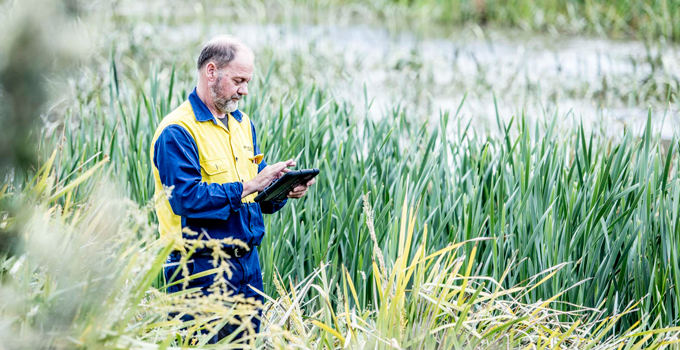
Power and water utilities can incur major penalties when natural values are insufficiently understood and poorly managed. Not only could the environment be damaged, but there could also be penalties for a compliance breach, increased costs and conditions for construction and operation, significant remediation costs, project disruption and delays, and delivery overruns.
On top of all of this, there’s no doubt that poor environmental management will damage your corporate reputation and reduce your level of acceptance by and engagement with the community and stakeholders, both at and potentially far beyond the local area.
Power and water asset owners and developers manage or have influence over large areas of natural assets. These environments often include flora and fauna on land and in waterways that are listed as threatened under state and national environmental legislation and/or international agreements.
A land manager or owner with a strong environmental management system will know and proactively manage these values. However, in many areas there is a lack of knowledge of natural values, which are consequently not included in an environmental management framework. These values are therefore at risk of adverse effects from operational decisions.
So what can you do to make sure you have a handle on your environmental risks?
Find out what you’ve got
A thorough review of available information will help you better understand the values you need to manage.
This means using existing data-sets and reports to understand the current knowledge base and identify any gaps. In other words, create an inventory of natural values for all your land and water assets. You will need to identify the flora, fauna and ecological community values on your land and in your waterways and lakes, and record their condition and their status.
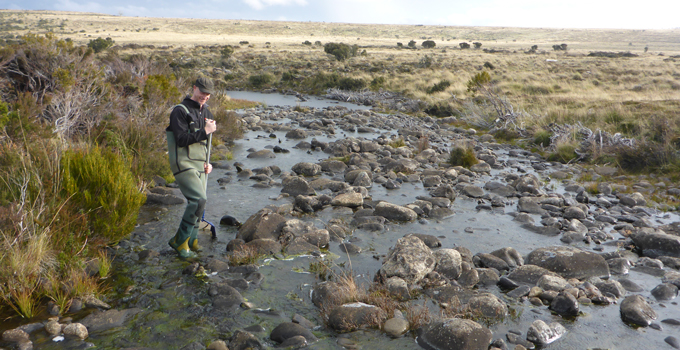
To understand the social values associated with your assets, you may also need to engage with other stakeholders and local communities to understand how they value and use your natural assets (e.g. fisheries, recreational users, water supply, transportation), as this will also influence management.
Incorporating the data into a spatial database accessible to everyone in the business will allow easy searching for flora and fauna values that may be affected by maintenance activities or new projects and ensure that relevant information about your natural assets is readily available for managers and field staff. However, this phase only identifies issues, and the degree of impact of a proposed management action on flora and fauna values is likely to require further interpretation by an ecologist.
If gaps are detected in the data or there is doubt about accuracy, field surveys can identify and verify natural values and record their condition. For example, vegetation and /or habitats have often been mapped from aerial photos and not verified in the field, so errors can arise in the attribution of a vegetation community or habitat type.
Understand your compliance requirements
Once you know what’s on your land or in your water, you can identify the potential regulatory and compliance issues.
Are there threatened species or communities listed under state or national legislation or international agreements? Are there weed or pest species or communities that have legislative requirements? Does analysis of existing water quality data highlight any trends that may affect values within the water-body or downstream (e.g. increased nutrient loading)?
If you already know what natural values you have on your land or water, you’ll be in a much better position to respond effectively to any legislative changes. You may even be ahead of the game!
Identify potential risks and their significance
Identifying and understanding risks to natural values under current and future operational scenarios is critical to successful and proactive environmental management. This requires some ‘big picture’ thinking in which the whole landscape, both terrestrial and aquatic, is considered.
A big-picture approach focuses on risks to ecological communities or functional ecosystems (e.g. wetland, lake or river) rather than extrapolating from localised information that may not reflect the broader risks. For example, to manage species at a habitat level rather than at site level, you need to identify and map habitat for threatened species across your natural assets as well as assess habitat quality.
In another example, a big-picture approach to water quality would involve having an understanding of the natural range of parameters at the local catchment scale, which may be different to recommendations in national water quality guidelines due to natural local conditions (such as the relatively low pH of tannic water bodies in peatland landscapes).

Many project risks can be mitigated if they are properly anticipated early and managed throughout the life of the project, minimising corporate, technical, environmental and social impacts and their associated costs. Having a comprehensive inventory of your natural assets will allow any threatened species or important ecological communities to be identified early in the planning phase for upgrades of existing assets or new projects. This will make the difference in understanding the effort required to avoid or minimise impacts.
The planning process is likely to be expedited because you will already know what your potential environmental impacts are and will have accounted for them in your project design, planning approval documentation and operational management plan.
This informed management approach also applies to maintenance programs, particularly weed and vegetation management, on easements and around assets. If you know where your high-value natural assets are, they can be accounted for in the maintenance program so that they will be protected.
Develop management approaches
Knowing which natural values require active management and which values may be best left alone is another key factor for successful environmental management.
Some natural values may be protected by default because they are associated with assets that are not accessible to the public (e.g. remote assets or those closed to the public because of safety risks). These natural values, particularly in intact remote wild areas, may be best managed by being left alone without any management intervention because they are not under pressure from human activities.
Other natural values may need active management and protection because they are under threat from human activities, introduced species or diseases. In this case, you need to consider the potential issues and consequences, plus the likelihood of them occurring, to evaluate the potential risk and significance of the issue.
Where the risk level is considered to be high, identify how the risk can be mitigated (e.g. restricting public access to a sensitive area while directing access to another less-sensitive area). Potential mitigation measures are generally best identified in consultation with other stakeholders, including user groups and the local community, to ensure that the measures are supported and endorsed by the community for greater success.
For example, an important conservation site such as a lake that supports threatened fish as well as recreational fish species will require a management approach supported by the angling community. That might mean developing hardened access points (e.g. tracks and boat ramps) in less-sensitive areas supported by anglers. Otherwise anglers will continue to develop their own access points, degrading lakeside habitats and potentially affecting important breeding or foraging habitat for threatened species.
Identify opportunities
If you proactively identify and manage the environmental values for which you are responsible, you may even stand to reap a range of extra benefits. You may identify natural values with potential economic and environmental value beyond the obvious.
For example, native vegetation in good condition on your land could be used to offset the loss of native vegetation associated with other projects you undertake. Or, possibly, land in good condition could be made available to other proponents for purchase as offsets for their projects. These hidden opportunities could be very valuable and make a major difference to project viability.
If you can make structured and systematic efforts to manage environmental issues proactively, you are far more likely to achieve environmental sustainability, as well as pave the way for project success, social licence and a positive reputation. For power and water asset developers and utilities, a genuine commitment and responsible approach to achieving greater operational sustainability is increasingly recognised as a key marker of success and corporate reputation.
Don’t wait. Act now to understand and manage your environmental risks.
If you would like to discuss how Entura can assist you with minimising risks and increasing sustainability, please contact Ray Brereton on +61 417 336 407.
About the author
Dr Eleni Taylor-Wood is Entura’s Principal Consultant, Environmental and Social Science. Eleni has 20 years’ experience successfully managing large-scale, complex projects, as well as providing expert advice and independent review for a range of infrastructure and planning projects. She has worked on projects around the world including in Australia, Mozambique, South Africa, Iceland, Colombia, India, Malaysia, China, Solomon Islands, Fiji and Papua New Guinea. Her experience includes environmental and social impact assessment and management, strategic management of wetlands and waterways, feasibility and approvals for new hydropower projects, environmental flow determination and assessment, and sustainability assessments. Eleni is currently one of eleven accredited assessors worldwide under the Hydropower Sustainability Assessment Protocol.
Raymond Brereton is a senior ecologist with 30 years’ experience in the field of fauna and flora survey and management. He has been involved in assessing the impacts of development on flora and fauna and their habitats, as well as providing advice on the development and implementation of policy and prescriptions for fauna and flora management across south-eastern Australia (Queensland, New South Wales, Victoria, South Australia and Tasmania). Raymond has a high level of technical expertise in the assessment and the management of threatened species and communities in both terrestrial and aquatic ecosystems in compliance with regulatory requirements
MORE THOUGHT LEADERSHIP ARTICLES
Winning over your solar farm community
Effective engagement can reduce community opposition to a solar farm, but, better yet, it has the potential to create a level of community support that results in locals themselves promoting it.

Regardless of the technology, any large-scale renewable energy project will attract attention from its nearby communities. Without a ‘social licence’ to operate, the project may face significant hurdles including negative publicity, public protest, litigation or even cancellation of permits.
Engaging with the host community early in the development stages is key to a successful project and developers may be required to demonstrate that they have done so, even before submitting a permit application. This will help assure authorities (and potential buyers) that the project has support.
These are our top community engagement tips for developers to ‘keep the sun shining’ on a large-scale solar project.
Know your community
Despite the exponential rate of increase in large-scale solar installations in recent years, it is still a relatively new technology. While some community members may be quite knowledgeable about renewable energy technology, others may know little.
Each person will have different attitudes and expectations of a solar farm, and engagement should include all stakeholders in the community to make sure nobody is left out of the conversation. Someone living close to the solar farm may be interested in how it will affect the value of their property or if PV panels will reflect light in the direction of their home. A business owner in town may be interested in employment opportunities or how construction will affect local roads. An obvious question for everyone is whether the project will lead to cheaper electricity!
A developer, owner or operator should identify and meet as many different stakeholders in the community as possible to get to know their individual interests and needs.
Design a relevant engagement program
A comprehensive engagement program must communicate accurate project information, set realistic expectations, listen to the community, incorporate feedback into project design, and find opportunities for the solar farm to ‘give back’ to the community in some way.
Well-planned projects need engagement strategies designed specifically for the community in which the project is located. Using a ‘one-size-fits-all’ approach won’t cater for the unique circumstances of each community.
To inform the choice of engagement methodologies and tools, developers should consider the size, interests and skills of the local and regional community, the number of neighbours, who the local influencers are, and what other energy developments are present in the region.
Methods to engage with different stakeholder groups will vary depending on the stage of the solar farm’s development and the objective of the engagement process at that stage. Engagement practitioners use a range of different communication tools, from more traditional techniques to social media, from ‘kitchen table’ meetings to reference groups and focus groups.
Communicate realistic expectations
Large-scale solar farms are generally less controversial than wind farms or hydropower projects due to the relatively low physical impact they have on communities and the local environment. However, there may still be questions and concerns in the community, especially for communities in remote and rural locations where there may not be any other large infrastructure.
Throwing scientific facts and figures at people to convince them of benefits or mitigate fears will not necessarily help concerned locals feel any more confident about a project. Anecdotal negative information can be readily found on the internet to undermine confidence, and some community members may distrust the intentions of developers from large corporations.
The task of building the community’s confidence in a project is therefore an important yet sometimes difficult activity. The best approach is to communicate any foreseeable short-term and long-term impacts as early as possible and in an open and non-defensive manner before the community dwells on the risks. Listening to the community and working together to identify social and environmental risks will help build trust between the project team and stakeholders.
Build trust and confidence
Genuine community engagement is not ‘spin’. It’s about building an open and ongoing relationship with local stakeholders. The more work that is put into building healthy relationships and trust, the stronger the foundation for achieving a social licence to operate.
As communities generally become more familiar with large-scale solar technology, there will likely be a shift towards greater community acceptance of solar projects. Until then, developers need to recognise the community’s interest in a project and take responsibility for explaining solar technology and identifying risks for the community.
Local stakeholders should be told about a project prior to applying for permits. By engaging early, the developer will have time to explain how solar technology works, outline the construction process, and conduct a social risk assessment. Preferably engagement should be face-to-face and consistent. People are far more likely to accept projects when they feel that they have been included, heard and respected.
Obtain a ‘social licence’, but don’t stop there
Obtaining a social licence to operate is essential. It can mean the solar farm and its owner are talked about positively in the region and the project encounters few hurdles. But obtaining a social licence is not the end of the journey. A social licence must be maintained throughout the project’s lifecycle.
Owners and operators can maintain a social licence through ongoing and regular communication with the local community and other key stakeholders. Communication should be two-way and communities should know how to easily provide feedback that is treated confidentially. Stakeholders should also trust that their concerns about the solar farm will be recorded and responded to in a timely manner. Evaluating and reporting on feedback will also help to promote a transparent and constructive process.
If you would like to find out more about how Entura can help you engage successfully with your solar farm project’s community, contact Silke Schwartz on +61 407 886 872 or Patrick Pease.
MORE THOUGHT LEADERSHIP ARTICLES
Maximising the benefits of GIS for better business decisions
‘Location, location, location!’ It’s a familiar catch-phrase in the real estate industry, but it’s just as relevant in the power and water sector. Wherever there’s location-related data, a geographic information system will guide better business decisions.
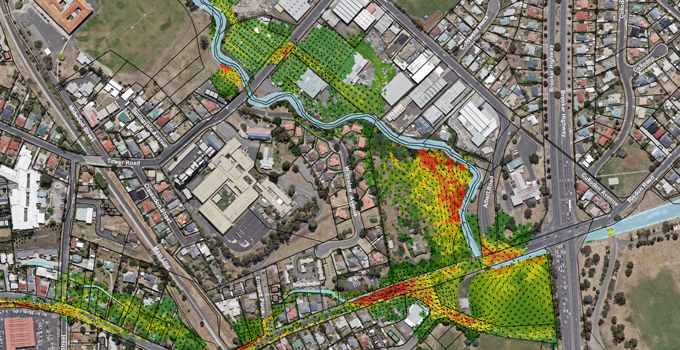
Mobile devices and apps are increasingly using location-based data collected via satellites, drones, LIDAR and other rapidly developing sensing and data capture technologies. With these advances, we are able to find relevant information more quickly and draw on that information to make informed decisions. We’re seeing this proliferate in everyday life through apps that help us navigate, find services and products, and make decisions ranging from the trivial to the profound.
Developers and managers of power and water infrastructure projects who embrace GIS (geographic information systems) stand to gain benefits on an even greater scale. Gathering high-quality spatial information and analysing it to guide business decisions will certainly improve productivity and the bottom line.
Better decisions are the necessary foundation for increased revenue, lower costs, greater efficiency and productivity, and reduced risks. So, if the technology is available and there’s so much to gain, why isn’t GIS being as widely used in the power and water sector as it could be? What may be holding businesses back from fully embracing this powerful and dynamic technology?
Do we really need to use GIS for this project?
All power and water projects involve location – from finding an optimum site for your project, to analysing combinations of spatial data to make the best management decisions or to predict events. Whenever you ask a ‘where?’ question, GIS can help. Where is the asset best located? Where are the constraints or hazards? Where are the reports of previous work done in this area? Where are the customers or opportunities?
In other words, rather than asking whether GIS is needed on a project, consider making GIS a default for every project. The real question should be “how can we maximise the benefits of using spatial data and GIS on this project?” GIS can offer business benefits far beyond the most commonly understood use: making a map.
Data capture in the field can now be streamlined – gone are the days of capturing field data with pen and paper. Users can now collect data on mobile devices, sync to databases while in the field, share data, and generate their own maps, queries and reports. Embracing these advances will save time and enable faster and better decisions.
As well as providing valuable business insights, spatial analysis and location intelligence can greatly improve communication and knowledge sharing – within project teams, with the broader business, and with the community and stakeholders – via tools such as web maps and apps, visual analysis and 3D modelling.
One of the most important applications is the simultaneous analysis of different spatial datasets to provide the best solutions or choices between alternative options, locations, objects and so on. This process is better known as multi-criteria analysis (MCA) and it can be used for many applications.
For example, MCA can be used to find the optimum site for your project taking into account a range of values such as local geology, threatened species, resource availability, land use and terrain, planning restrictions, communities and demographics. Using MCA, you can establish areas of best fit for your project based on thematic overviews of areas of constraint, cost of construction, access and transportation routes.
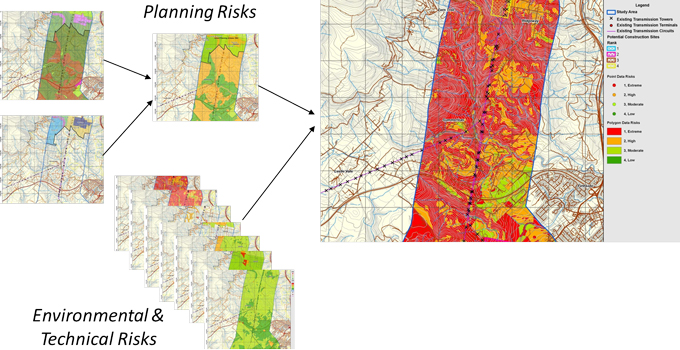
Risks such as bushfire, weeds, threatened species, pollution sources, landslides and erosion can also be more easily and fully understood, supporting your ongoing site management of such issues.
GIS also links with document management, asset management, business intelligence and enterprise resource planning (ERP) systems. It can act as a portal, creating a central point of easy access, pulling together information and making it available on one of the simplest forms to interpret – a map.
Of course GIS is not the answer to everything, and it is not a standalone platform. However, there’s much it can offer across many different business activities, working together with other business systems.
What about the costs?
The return on investment of using GIS should be positive if it is used appropriately. For site selection of power and water projects, using GIS is a no-brainer. For example, using GIS to find the best site for a wind farm – locating the best winds, minimal constraints, good proximity to existing infrastructure and appropriate land use – will obviously result in vastly greater returns than siting the wind farm in an inferior location.
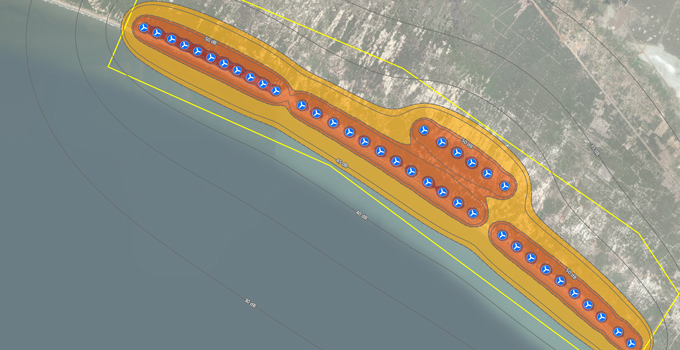
Some examples may be less immediately apparent, but equally valuable – for example, using GIS to increase efficiencies in everyday workflows. If your workers are taking an extra half hour every time they need to find previous work completed in an area, this time can add up quickly. Or perhaps they can’t find previous information, so work is re-done unnecessarily. These costs will keep adding up. Instead you could use a GIS web map to locate all your previous reports and projects, so that a simple click on a map finds the files and saves hours (if not days) of time.
Do we need specialist software or skillsets?
With most things, you do need specialised skillsets and software to get good results, and of course bad data in equals bad data out. Users of GIS do need to understand and assess the spatial data needs in each application.
You could undertake some GIS work yourself using free or open-source software. However, be aware of the risks of using data or tools that aren’t fit for purpose. Just because you know how to use Microsoft Word, doesn’t mean you could write a detailed report outside your area of expertise!
We have seen cases where coarse-resolution data has been used to infer finer project details and costs, resulting in poor decisions. We have also seen inexperienced operators make invalid assumptions. To get the best results, you need to be sure that you’re using the technology wisely.
If you are engaging a power, water or environmental consultant on a project, they are likely to have access to GIS capability; however, GIS is still often underutilised. When deciding who to engage on your project, ask your consultant how they will maximise the benefits of GIS to produce better outcomes for your project.
To discuss how Entura can help you harness the potential of GIS to improve your power and water project decisions and outcomes, contact Stephen Thomas on +61 3 6245 4511, Patrick Pease or Phillip Ellerton on +61 439 010 172.
About the authors
Stephen Thomas is Team Leader and Senior Technical Officer with Entura, specialising in geographic information systems, 3D visualisation and CAD software. Steve has over twenty-six years of technical experience and specialises in environmental assessments and approvals for engineering surveys and property. He has created 3D models and animations of proposed developments including wind farms, urban landscapes and city frameworks. Steve’s work on the Hobart Waterfront 3D model won an international award in geospatial modelling.
MORE THOUGHT LEADERSHIP ARTICLES
‘Nexus thinking’ for a secure and sustainable future
As the global population continues to grow, how can utilities and water managers balance the increasing and interrelated pressures on water, energy and food?
The complex triangular relationship among these three pillars of life is known as the ‘water-energy-food nexus’. It’s an intricate puzzle, in which the increased demand for each limited resource can significantly affect the security of all three.

According to the International Renewable Energy Agency, over the next few decades, global growth in population, economic development and urbanisation are expected to raise demands for water and food by 50% and to double the demand for energy. Water, energy and food are all fundamental to growing economies, alleviating poverty, and improving health and educational opportunities worldwide. To create a sustainable future, we must seek holistic and integrated solutions for water, energy and food challenges , as well as the appropriate balances amongst them.
With water being so central to food security and energy security, the potential impacts of climate change on water resources are of increasing concern. Climate change is likely to raise average temperatures in many locations, change the patterns of rainfall and inflows, and affect the frequency and severity of extreme weather events such as drought or floods – all of which increase vulnerabilities for water, food and energy resources already under strain.
A nexus approach
Our experiences throughout Australia and the Asia-Pacific region demonstrate that there is no single solution to the challenges of this nexus. It is really about a way of thinking and approaching decisions rather than a fixed solution or response.
These five broad considerations are likely to contribute to improved nexus outcomes.
Promoting and adopting ‘nexus thinking’
‘Nexus thinking’ means considering and understanding water, food and energy and their interrelationships, rather than viewing any in isolation. It is a strategic and holistic style of thinking that considers long-term implications across the nexus, weighing up and balancing social, economic and environmental goals.
Nexus thinking looks at the big picture: considering the whole catchment or river basin, trans-boundary issues, multiple uses (existing and future) and cumulative effects. It also involves thinking across agencies and organisations where responsibilities for water, food and energy lie.
Gathering the best information to understand nexus challenges
Responses to nexus challenges are more likely to be effective and sustainable if they are based on an informed and risk-based understanding of present conditions and possible future scenarios (taking into account interrelationships across sectors and regions).

This means that decision-makers need to understand the resource availability, current demand, known impacts, development opportunities and potential climate change implications in a given situation. They also need to understand what stakeholders and communities need, and explore opportunities for additional benefits to be realised.
Fostering collaboration among government, regulators, industry and communities
All stakeholders can benefit from collaborative and cooperative responses to the nexus and to stewardship of resources. The potential wins include better economic outcomes, improved reputation, reduced risks, avoided conflict, and opportunities for greater synergies. Reaping the benefits will require partnerships and cooperation among food-producing industries, the energy sector and other water-dependent industries, as well as local communities.
It’s also essential that governments, regulators and communities are closely involved in all decisions and developments affecting water, energy and food resources so that different priorities and opportunities can be considered. At a policy and regulatory level, cohesive and stable governance, policy and strategies are needed to facilitate and encourage the right collaboration that brings benefits to all stakeholders.
Assessing risks and building climate resilience
The water-energy-food nexus brings risks as well as opportunities . Interrelationships between water, energy and food, and the threats posed by climate change, should be built into risk assessments in each sector. State-of-the-art data collection, modelling and forecasting can assist businesses, governments and communities to better understand and mitigate their specific climate-related vulnerabilities and take action towards building greater resilience to future climate change impacts.
Innovating
In the water, energy and food sectors, technological and other innovations continue to expand the opportunities for improving productivity and resource efficiency for long-term sustainability of pressured resources.
Nexus challenges may also bring opportunities
The nexus is not only a dynamic of ongoing resource competition. Integrated planning offers opportunities for potential synergies and benefits among sectors.
For example, in the hydropower sector, electricity generation is intrinsically linked with water availability. The need for water for irrigation to produce food and to drive agricultural productivity may compete with water requirements for hydropower generation. Hydropower’s water needs may also compete with the requirements of urban water supply, other industries and environmental and social needs.
However, renewable energy resources such as hydropower can also offer benefits to the water and food sectors through improving water resource management, providing multipurpose storages, contributing to the development of water supply infrastructure and, of course, generating the electricity critical to food-producing industries.
Many existing hydropower storages, both in Australia and internationally, were developed solely to supply water for energy generation. However, over time and with increasing competition for water and food, the storages have become multipurpose, often providing water for domestic supply, irrigation, and commercial and recreational fisheries.
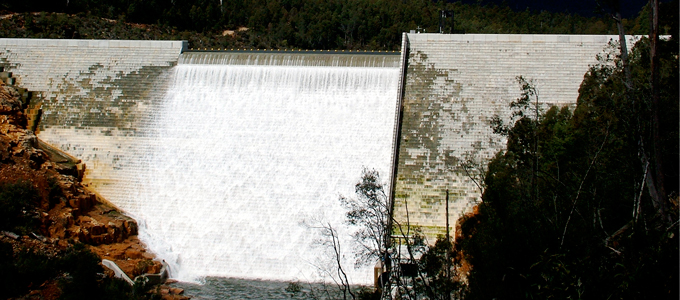
In South-East Asia, some hydropower storages are now more important as a source of irrigation water for downstream communities than for the energy they generate. By providing water to the downstream communities, irrigation and food production has increased significantly since development of the schemes, lifting the economic development of the region and providing benefits across the community.
Integrating other renewable energies into water supply, irrigation and food production can also provide mutual benefits, such as utilising renewable energy for pumping on farms or for water desalination. Incorporating small hydropower into existing water infrastructure can improve efficiencies and create new low-carbon income streams to support effective water supply delivery. Another innovation of attaching solar PV to covers on water storages provides electricity for pumping while minimising evaporation and maximising water availability.
Whether at small-scale single utility or local geographic area or at a national or multinational scale, nexus thinking can bring about mutual benefits for energy, water and food outcomes .
If you would like to find out more about how Entura can help you develop a sustainable water or energy solution or respond to the challenges of the water-energy-food nexus, contact Dr Eleni Taylor-Wood on +61 3 6245 4582 or David Fuller on +61 438 559 763
About the authors
Dr Eleni Taylor-Wood is Entura’s Principal Consultant, Environmental and Social Science. Eleni has more than 20 years’ experience successfully managing large-scale, complex projects that run over several years, as well as providing expert advice and independent review for a range of infrastructure and planning projects. She has worked on projects around the world including in Australia, Mozambique, South Africa, Iceland, Colombia, India, Malaysia, Mekong, Solomon Islands, Fiji and Papua New Guinea. Her experience covers a vast gamut of studies including: environmental and social impact assessment and management; strategic management of wetlands and waterway; feasibility and approvals for new hydropower projects, environmental flow determination and assessment, and sustainability assessments. Eleni is currently one of eleven Accredited Assessors under the Hydropower Sustainability Assessment Protocol worldwide.
David Fuller is Entura’s Principal Consultant, Water Management and Technology. David has more than 30 years’ experience working on water management projects across Australia and overseas. He has successfully delivered projects for local, regional, state and national government agencies; and for private sector clients in the irrigation, coal seam gas, mining and energy generation sectors. David specialises in engineering and environmental hydrology, and water management. He also has expertise in data management systems, statistics, hydraulics, water quality, ecological risk assessment and natural resource economics.
MORE THOUGHT LEADERSHIP ARTICLES
Batteries vs pumped hydro – are they sustainable?
A sustainable grid needs sustainable energy sources. While there’s no doubt that it makes sense to store renewable energy, whether in batteries or in a pumped hydro scheme, just how sustainable are these technologies?
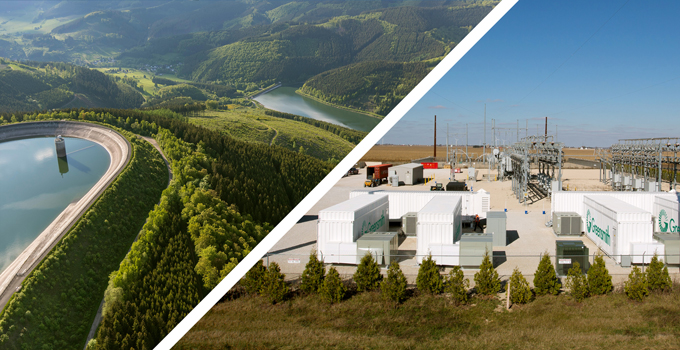
As we move rapidly towards ever-greater levels of wind and solar power in the network, increasing quantities of storage are needed to smooth intermittency and ensure secure supply. Pumped hydro energy storage and batteries are likely to do much of the heavy lifting in storing renewable energy and dispatching it when power demand exceeds availability or when the price is right.
We’ve previously compared the two technologies in terms of their costs, the speed with which they can be deployed, and their ability to support the grid. Here we compare their sustainability in terms of storage efficiency and capacity, safety, use of scarce resources, and impacts through all stages of their lifecycle.
Storage efficiency and capacity
For both batteries and pumped hydro, some electricity is lost when charging and discharging the stored energy. The round-trip efficiency of both technologies is usually around 75% to 80%. This level of efficiency for either technology represents a significant displacement of non-renewable generation if we assume that the stored generation would not otherwise occur.
A particular consideration for batteries is degradation. Batteries degrade as they age, which decreases the amount they can store. The expected life of the batteries that will be used for the recently announced battery storage project in South Australia is about 15 years (depending on how the batteries are operated). By the end of that time, the capacity of the batteries is expected to have dropped to less than 70% of their original capacity.
To maintain a reliable and steady capacity for storage as batteries age and degrade, large-scale battery plants will require ongoing staged installation and replacement of batteries. In comparison, the degradation of pumped storage is close to zero. With appropriate maintenance, peak output can be sustained indefinitely.
Safety
No storage solution can be considered sustainable unless it is safe. The greatest risk relating to pumped storage is dam safety. If it occurs, dam failure can affect downstream communities and the environment, with its impact potential likely to be far greater than a battery safety incident. Nevertheless, pumped hydro technology is mature, dam risks are generally well understood and managed, and the frequency of dam safety events is low.
The main safety concern for batteries is thermal runaway leading to explosions and fires. The severity of this risk will depend on how a battery project is implemented. In a modular arrangement, thermal runaway would be localised, not affecting the whole bank. However, because of the very rapid deployment of evolving battery technologies, safety standards may not be rigorously enforced.
Impacts on land and water
Pumped hydro and grid-scale battery plants may have environmental and land-use impacts. These impacts would vary depending on the sensitivity of the site selected.
A grid-scale battery facility needs a relatively small parcel of land and is likely to be able to be created very close to the energy demand or where generation occurs. Land in these areas has often already been disturbed and the new operations may have little extra environmental impact. Land and water impacts of batteries relate more to their disposal at the end of their effective life, and to the extraction of the resources to produce new batteries.
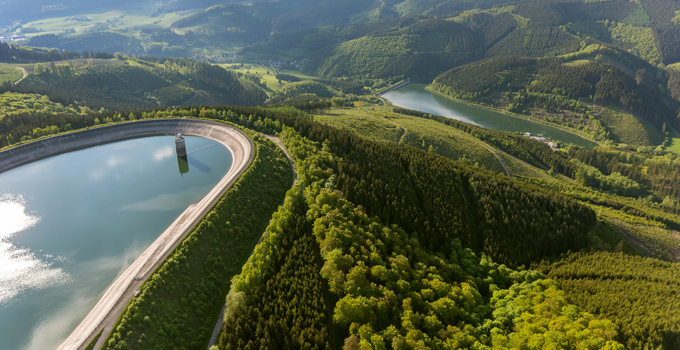
Pumped hydro requires a relatively larger parcel of land with a very particular topography, and may be far from the location of the demand. Any potential environmental impacts associated with construction and operation need to be considered and mitigated, including those immediately associated with the site, as well as downstream.
In most construction of new pumped hydro, sites are selected where impacts can be mitigated to acceptable levels, for example by using existing reservoirs, or locating ‘closed loop’ systems away from rivers. Although these arrangements will have lower overall impacts, some environmental challenges may still occur during construction when existing water is removed from the site as well as finding a source of water without impacting the environment and other users.
Environmental impacts during operation of pumped hydro are minimal. However, the ecology within the reservoirs will need to adapt to frequently changing water levels, reducing diversity in the system especially within fringing communities.
In all pumped hydro systems, water is re-used over and over again, extracting maximum value from the resource. Nevertheless, depending on the configuration of the pumped hydro project, there may be an ongoing demand for water to top up the storages to counter evaporation.
Minerals and materials
Batteries and pumped hydro require a range of different resources and materials. Lithium-ion batteries use common materials such as plastic and steel as well as chemicals and minerals such as lithium, graphite, nickel and cobalt. Although pumped hydro mainly relies on common building materials such as concrete and steel, the quantities of these materials and the construction impacts can be significant.
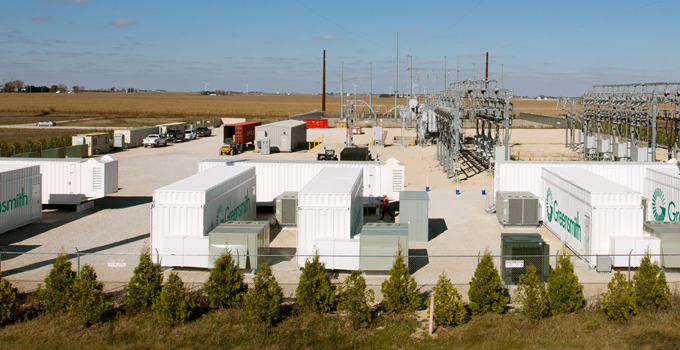
Image courtesy of Greensmith, a Wärtsilä Energy Solutions company.
Determining the ultimate sustainability of the required resources and materials for both technologies needs to take account of the full lifecycle and supply chain (mining, processing, refining and manufacturing) as well as end-of-life issues such as recycling, disposal or decommissioning.
Currently, the environmental and health impacts of mining are a significant sustainability concern for the battery industry, and impacts are likely to intensify as worldwide demand for the necessary minerals rapidly increases. Short-term availability of many of the necessary minerals for battery development, such as lithium, appears sufficient, yet security of supply could be compromised by geo-political factors, and long-term availability will depend on levels of demand.
Ultimately, the minerals used in lithium-ion batteries are finite resources, so limiting or reducing their extraction (for example, through greater recycling or substitution for another battery technology) would increase longer term sustainability.
End of life
A battery’s life depends on the technology and on frequency of charging and discharging. Once their effective life is up, the batteries must be disposed of and replaced. Disposal of batteries is a problem we’re yet to face, but as large-scale battery storage proliferates, increasing numbers of batteries will enter the global waste stream. Without careful management of disposal, what cannot be recycled may end up in landfill and may be corrosive, flammable, or could leach toxins into soil and water.
The development of cost-effective and efficient battery recycling methods is still in its infancy.
Although most of the components of batteries can be recycled to some extent, recycling is currently expensive and there is insufficient volume to encourage commercial enterprises to take on recycling the new generation of batteries. In time, improved recovery and re-use of materials will certainly increase the sustainability of battery storage, preserving virgin resources and reducing the impacts of extraction and processing.
End-of-life considerations for pumped hydro seem very distant right now due to hydropower’s longevity, but sustainable decommissioning still needs to be planned for, including managing the impacts on the downstream environment if a dam is removed and rehabilitating the reservoir area.
Lifecycle analysis
At this early stage of development of large-scale battery technology, comprehensive lifecycle analysis is limited by the diversity of battery materials and widely different scenarios of charging, battery life and recycling.
In contrast, the full lifecycle of pumped hydro is better understood due to the maturity of the technology. Pumped hydro is not without impacts, but the risks are known and generally manageable. A major advantage of pumped hydro over batteries is that the expected life of pumped hydro is more than 100 years, or effectively unlimited with appropriate maintenance.
Batteries may have a lower upfront cost than pumped hydro and be easier to approve and install; however, they are likely to require greater management over time. If a projection is made based on current information, the full lifecycle cost and impact of batteries may be greater than hydro across the long term, particularly when mining, recycling and disposal are taken into account. Yet, battery technology is likely to improve very rapidly, which would tighten the gap on pumped hydro’s current lifecycle advantage.
A greener grid
Worldwide, increased levels of renewable energy will lead to a greener grid. It is easy to recognise the sustainability benefits of using a storage solution such as pumped hydro or batteries to further enable the decarbonisation of the network through greater uptake of renewable energy. However, the storage solutions that enable more renewables must also be sustainable – not only in the use phase, but also upstream and downstream.
It is difficult to make a straightforward comparison of the sustainability credentials of pumped hydro and battery storage technologies at their very different stages of maturity. As battery technology is still evolving, its overall sustainability is still somewhat uncertain, but this will change with experience and improvements in battery life and recycling. Meanwhile, pumped hydro projects can last up to a century and associated risks are known and can be mitigated.
Either way, as we redevelop the electricity grid, we will also need a mature approach to lifecycle analysis of our storage solutions.
About the authors
Donald Vaughan is Entura’s Technical Director, Power. He has more than 25 years of experience providing advice on regulatory and technical requirements for generators, substations and transmission systems. Donald specialises in the performance of power systems. His experience with generating units, governors and excitation systems provides a helpful perspective on how the physical electrical network behaves and how it can support the transition to a high renewables environment.
Nick West is a civil engineer at Entura with 16 years of experience, primarily in hydraulics and hydropower. Nick’s skills range from the technical analysis of the layout of hydropower projects to the preparation of contractual project documents and computational hydraulic modelling. Nick was a key team member of the Kidston Pumped Storage Project Technical Feasibility Study.
MORE THOUGHT LEADERSHIP ARTICLES
Building climate resilience into operations: Hydro Tasmania’s journey
Climate change presents major risks for power and water businesses. To best prepare for the impacts of extreme or changing weather conditions, asset managers need to act now to build climate resilience into operations and ongoing risk management.
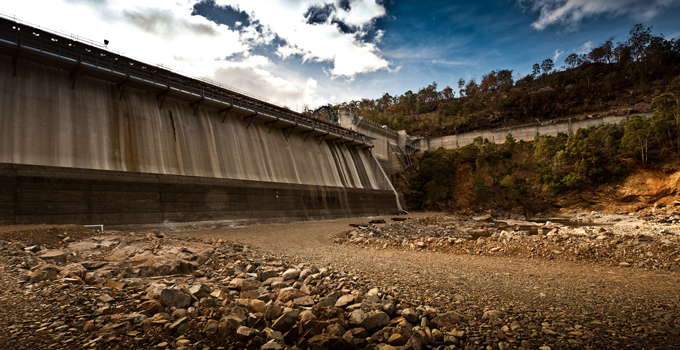
Around the world, businesses and communities face the many risks of climate change such as higher temperatures, changes in water availability and rainfall, more frequent and severe weather events. For power and water businesses, these may lead to major infrastructure damage and financial and environmental consequences.
In 2015 to 2016, these hypothetical risks became a challenging reality for Hydro Tasmania, Australia’s largest renewable energy producer and water manager. Hydro Tasmania faced unprecedented extreme weather conditions from September 2015 to June 2016 – and managed to come through the crisis while still safeguarding Tasmania’s ongoing access to high-quality, reliable water and power, and limiting environmental consequences and asset damage.
Entura supported Hydro Tasmania’s response to this major climate-related challenge through a range of earlier best-practice resilience-building measures, and significant interventions across a range of areas during the crisis itself.
What happened in 2015-2016?
Although Hydro Tasmania had experienced some variability in the past in Tasmania’s climate patterns, and despite understanding the risk of increasing future climate variability, the extreme dry conditions of September 2015 to April 2016 were unseasonal, unexpected and unprecedented. In Tasmania, summer inflows are traditionally low, but in this case, the usually dry summer was preceded by record-low spring inflows. Below-average rainfall across both spring and summer was the lowest recorded in 50 years.
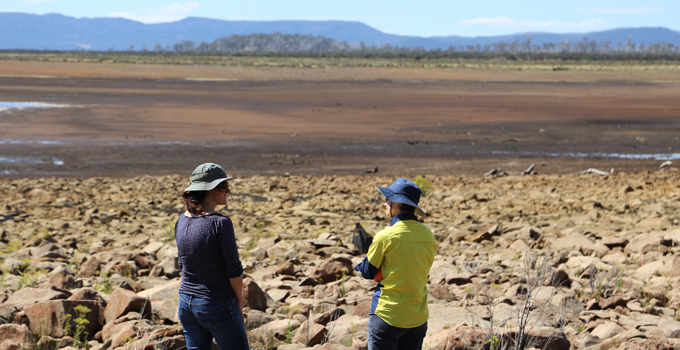
In normal operating conditions, low inflows could have been mitigated by importing power from mainland Australia across the undersea interconnector cable, Basslink, so that storages could be maintained. Yet, in another unprecedented scenario, in December 2015 the Basslink interconnector became inoperable just as summer arrived. Hydro Tasmania was now no longer connected to Australia’s national electricity market and many months remained before expected autumn/winter rains.
By late April 2016, Hydro Tasmania was experiencing its lowest storage levels ever, down to 12.5% total energy in storage, and serious environmental risks were emerging in some of its sites.
To compound the challenges, in January and February 2016 at least 70 separate fires were listed in Tasmania’s north-west, west, south-west and central highlands.
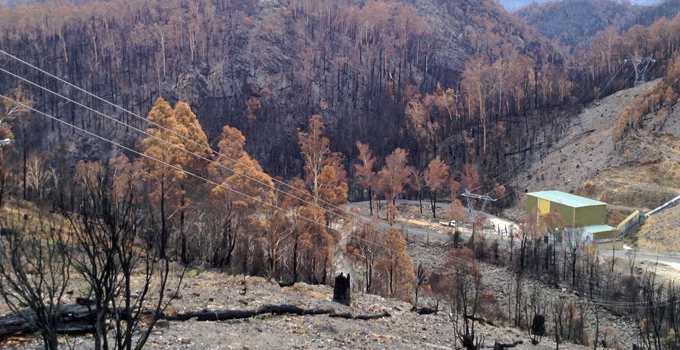
These extraordinary circumstances combined to present Hydro Tasmania with a major operational challenge. How could it keep the lights on and keep businesses operating in Tasmania while also protecting the environmental values associated with water storages and preserving the condition of its assets?
When the drought broke, conditions shifted from one extreme to another. Floods in June 2016 in northern Tasmania hit historic highs, exceeding all previous flood records in many locations. Several river-level measurement stations experienced the highest water levels on record.
How was the crisis managed?
Hydro Tasmania’s climate resilience and risk management strategies were called into action. Entura actively supported Hydro Tasmania through the energy supply challenge across a range of measures.
Generation planning and supply
To maintain adequate power supply, Hydro Tasmania drew on generation modelling and planning based on rainfall forecasts, climate model outlooks, and known and predicted electricity demand.
Voluntary reductions in major industrial loads were negotiated, and actions were taken to assess and instigate alternative generation options, such as restoring gas generation and implementing 200 MW of temporary diesel generation to bolster power generation. Entura assisted Hydro Tasmania to identify and assess feasible generation options and sites, and to progress these options through approvals and into operation.
Through these integrated and rapidly executed measures, Hydro Tasmania was able to maintain electricity supply for Tasmania without any outages for domestic users.
Environmental management and multiple water use
Another critical aspect of the successful result drew on Entura’s expertise in environmental management. Environmental impacts were monitored throughout the crisis. Lake-level risk bands were reassessed to better protect water quality and threatened species and to limit the long-term impacts on environmental values.
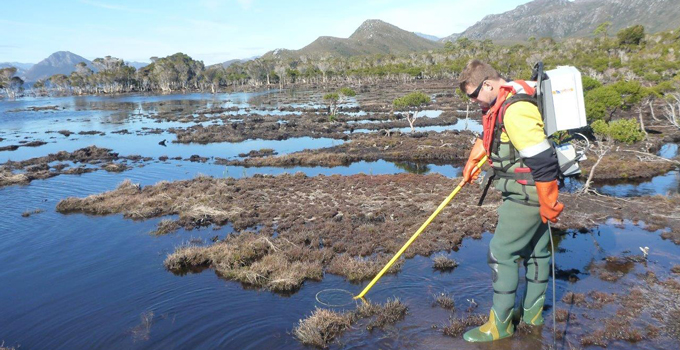
Water management also considered and mitigated impacts on other water users, such as boating, recreational fishing and water supply.
Bushfire management
The bushfires experienced across the state during the summer period did not adversely affect Tasmania’s energy security, as Bushfire Preparedness Fire Management Plans were already in place, and were activated to protect individual power stations and key assets through fuel reduction and other measures.
Dam safety and monitoring
Despite the extreme flood conditions, dams and spillways operated well within their design parameters, indicating that Hydro Tasmania’s ongoing dam monitoring and dam safety systems were robust. Safety inspections after the floods found only minor damage to non-critical elements of some dams.
During the high rainfall conditions, monitoring of dams and waterways provided alerts to downstream communities.
Road and asset management
Another consequence of the flooding was damage to some of Hydro Tasmania’s secondary assets (roads, canals) due to landslips, and the loss of some river-flow monitoring sites. Entura assisted with assessment and rectification of this damage.
Success drew on prior climate-resilience preparation
Ultimately, the example of Hydro Tasmania demonstrates climate resilience in practice. It shows how an investment in climate resilience enables a power and water business to be better prepared, more flexible and more robust in the face of a climate ‘shock’.
Hydro Tasmania’s management of the crisis required a comprehensive understanding of Tasmania’s climate and catchments. Entura’s involvement in 2007 in developing a Climate Change Response Strategy had provided a basis for this understanding, and a crucial input into identifying the risks and opportunities stemming from climate change.

Further inputs for climate resilience came through the collaboration in 2008 to 2010 between Entura and the CSIRO (Australia’s national scientific research organisation) on the first fine-scale climate and river system modelling for Tasmania, through the Climate Futures for Tasmania and the Tasmania Sustainable Yields projects.
The results of that research were state-of-the-art regional climate modelling and hydrological models to project future catchment yields for Tasmania. The modelling indicated that under climate change Tasmania could expect gradual temperature rises, changes in rainfall patterns over coastal regions, reduced rainfall over central Tasmania, changes to run-off patterns, and changes to the frequency and severity of extreme weather events including increased rainfall intensity and floods.
This modelling was critical in enabling Hydro Tasmania to plan and balance generation and storage levels over a range of demand and inflow scenarios and to assess environmental impacts during the extended period of drought.
Another key aspect of managing the energy supply challenges through the drought involved setting up supplementary diesel generation. This drew on Entura’s expertise and extensive involvement in developing hybrid off-grid renewable energy systems.
Hydro Tasmania’s climate resilience also involved being prepared for the drought to break. Key contributions from Entura included flood forecasting and flood support systems, ongoing support of Hydro Tasmania’s dam safety and emergency planning programs, and prior involvement in upgrading dams and designing spillways to withstand predicted increases in the frequency and magnitude of floods.
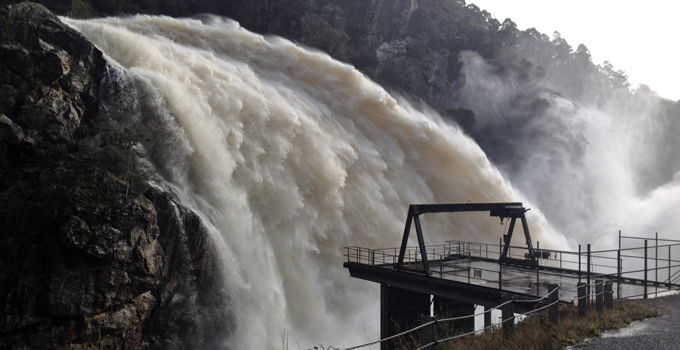
Entura also supported Hydro Tasmania’s procedures and ongoing activities to manage the secondary impacts of the fires and floods (such as damage to infrastructure), as well as the risks posed by low lake levels to social and environmental values. Entura’s environmental scientists monitored threats to aquatic flora and fauna through the 2015/16 crisis. To ensure the least likelihood of long-term or irreversible environmental damage, Hydro Tasmania’s environmental risk bands were revised.
Investing in your climate resilience
Any proactive and sustainable power or water business needs to invest in understanding the range, likelihood and consequences of the potential impacts of climate change for their current and planned systems and operations – whether for hydropower, transmission, dams, irrigation or water supply – and how to avoid or mitigate the impacts.
The more businesses understand the potential impacts of climate change and risks to their projects and operations, the better they can prepare, adapt, and build resilience to climate change impacts.
If you would like to learn more about building greater climate resilience into your project or operations, please contact Dr Eleni Taylor-Wood on +61 3 6245 4582, Phillip Ellerton on +61 439 010 172 or Shekhar Prince on +61 412 402 110.
About the authors
Tammy Chu is the Managing Director of Entura, one of the world’s most experienced specialist power and water consulting firms. She is responsible for Entura’s business strategy, performance and services to clients, and is part of Hydro Tasmania’s Leadership Group. As a civil engineer, Tammy specialised in the design and construction of mini-hydro and hydropower systems, project management, hydropower investigations, prefeasibility and feasibility studies, environmental assessments and approvals, resource investigations and resource water management. Tammy is a member of the Board of the International Hydropower Association. She was the first female and now past president of the Tasmanian Division of Engineers Australia, and was an Engineers Australia National Congress representative.
Dr Eleni Taylor-Wood is Entura’s Principal Consultant, Environmental and Social Science. Eleni has more than 20 years’ experience successfully managing large-scale, complex projects that run over several years, as well as providing expert advice and independent review for a range of infrastructure and planning projects. She has worked on projects around the world including in Australia, Mozambique, South Africa, Iceland, Colombia, India, Malaysia, Mekong, Solomon Islands, Fiji and Papua New Guinea. Her experience covers a vast gamut of studies including: environmental and social impact assessment and management; strategic management of wetlands and waterway; feasibility and approvals for new hydropower projects, environmental flow determination and assessment, and sustainability assessments. Eleni is currently one of eleven Accredited Assessors under the Hydropower Sustainability Assessment Protocol worldwide.
MORE THOUGHT LEADERSHIP ARTICLES
Overcoming the barriers to pumped storage hydropower
With energy reliability a hot topic in Australia, eyes are now turning to pumped storage hydropower… but what has been holding it back?

There are only three pumped storage hydropower projects in Australia, with the most recent completed more than thirty years ago. This is despite the ability of pumped storage hydropower projects to provide the large-scale storage that would complement increasing levels of renewable energy. Why is this, and what are the barriers to developing more Australian pumped storage hydropower projects?
Around the world, pumped storage hydropower projects make up the vast majority of grid energy storage and have traditionally been used by energy utilities to supply additional power to a grid during times of highest demand.
As part of a portfolio of power stations, a utility might operate a pumped storage project infrequently only, if the cost of pumping the water back to the upper storage exceeds the revenue that can be generated from its release.
The main issue facing developers trying to prove the viability of a new pumped storage project is that a sufficient price differential is required to pay for the pumping and to account for the efficiency losses in transmission, pumping and generation. The generation price needs to be sufficiently higher than the pumping price just to repay the variable pumping costs. To repay the heavy capital investment, a margin is required over and above the break-even cost of pumping. This is particularly true where proposed developments are ‘stand-alone’ and cannot be optimised as part of a corporate generation portfolio.
In recent years, electricity price spikes have been irregular with few occurrences each year. Due to the significant capital costs, a pumped storage scheme would require a certain number of pumping/generation cycles at high or maximum pricing to pay a return on investment. These price spikes are unpredictable, so building a business case around these events is risky.
Historically, the daily fluctuation of power prices has not been sufficient or regular enough to attract pumped storage developers. This is beginning to change with increasing penetration of renewable energy leading to an increase in both low and high price periods. More frequent, sustained periods of hot weather (as predicted by climate change models) will also drive up demand for power and therefore the market price.
In the last few months, volatility has greatly increased, creating a greater differential between baseload and peak pricing. This will increase the viability of pumped storage schemes, although the unpredictability and challenges of financing capital intensive assets will remain.
But, even when the economics are right, there are still some other barriers that proponents of pumped storage projects need to overcome:
Finding the right site
Pumped storage projects require significant capital for development. Minimising the cost of construction and operation is key to the successful development of a project. Choosing the right location is a matter of identifying a site with ideal topography, a source of water and good proximity to and location within the transmission network.
A wealth of information is available that is relevant to identifying potential pumped storage hydropower sites. Concept studies for pumped storage hydropower sites can screen potential sites quickly and offer developers greater insight into possible opportunities.
Negotiating access to appropriate sites for pumped storage
While a pumped storage project generally has a significantly smaller footprint than a traditional hydropower project, the features of natural topography that are ideal for pumped storage – high, steep hillsides or cliffs – tend also to be places of great natural beauty and are often designated as reserves, are expensive private land, or have high environmental or social value.
State governments can assist here through streamlined planning and approvals processes for infrastructure developments. This can make sure that the challenges of developing sites do not become insurmountable for developers.
Perceived environmental impacts
Pumped storage projects can occupy many square kilometres and also require transmission lines to connect to the electricity market. Like traditional hydropower projects, pumped storage projects need to attend to environmental issues associated with the project. Environmental impacts for pumped storage projects are assessed in the same manner as for all infrastructure developments.
If the impacts of a project can be mitigated to the satisfaction of the relevant regulatory body and international Standards (such as the International Hydropower Association and International Finance Corporation), a pumped storage hydropower project should face no greater hurdle than any other infrastructure project in this respect.
A pumped storage project may also have to deal with the perception that it uses carbon-intensive thermal power to pump water during the pumping cycle. This may be true unless there is a surplus of renewable energy available, in which case the pumped storage project could be seen to be using this excess renewable energy for pumping. As renewable energy penetration grows, the opportunities for storing surplus renewable energy will increase.
An unfavourable regulatory framework
Inconsistent and uncertain policy positions of the major political parties at both federal and state levels reduce confidence in the energy industry, which deters investment. With debate raging over energy security, a bipartisan view on energy policy, which transcends party politics and the electoral cycle, is urgently needed.
Existing mechanisms are in place to support the renewable energy industry. The Renewable Energy Target (RET) promotes investment in renewable energy projects; however, pumped storage is specifically excluded from the RET where the energy used for pumping exceeds the energy generated. Current policy would have to be amended or complementary legislation enacted in order to reward large-scale storage for the service it provides.
Such changes could include market mechanisms for large-scale storage that could offer incentives for providing inertia and ancillary services from storage at times of peak demand as well as power. Another possible change could be to ensure that large-scale storage asset owners are not penalised under the RET for energy used in the pumping process. This would encourage the development of energy storage as a complement to the growth of renewable energy.
High cost of development activities
The long lead times and high development costs of pumped storage projects are major deterrents to developers. Projects generally take more than 4 to 5 years from the point of conception to ‘power on’, and require millions of dollars of capital for development and hundreds of millions for construction. In other words, when funding is first committed, it may not see a return for five years or more.
In an effort to overcome this barrier, the Australian Renewable Energy Agency (ARENA) has indicated it will allocate at least $20 million to finance the accelerated development of flexible capacity and large-scale storage projects. The Clean Energy Finance Corporation (CEFC) has also committed to provide successful ARENA funding recipients with the opportunity to secure long-term debt finance to support their projects.
With an increasing interest and emphasis on storage in a power system that is becoming increasingly unreliable (e.g. load shedding in South Australia and lack of reserve events in New South Wales), and with finance from ARENA and CEFC for large-scale storage, the barriers to pumped storage development are gradually diminishing. This action can’t come soon enough for residents suffering through blackouts on days over 40°C.
If you would like to discuss how Entura can help you overcome the barriers for a pumped storage hydropower project, please contact Patrick Pease, Nick West on +61 408 952 315, or Richard Herweynen on +61 3 6245 4130.
A version of this article has been previously published as an op-ed in the Adelaide Advertiser.
About the authors
Nick West is a civil engineer at Entura with 16 years of experience, primarily in hydraulics and hydropower. Nick’s skills range from the technical analysis of the layout of hydropower projects to the preparation of contractual project documents and computational hydraulic modelling. Nick was a key team member of the Kidston Pumped Storage Project Technical Feasibility Study and was involved throughout the development and construction of the Neusberg Hydroelectric Project in South Africa. Nick has successfully completed projects ranging from hydraulic design for small residential developments to the feasibility study of a cascade of four large hydroelectric projects in Malaysia.
Richard Herweynen is Entura’s Technical Director, Water. Richard has three decades of experience in dam and hydropower engineering, and has worked throughout the Indo-Pacific region on both dam and hydropower projects, covering all aspects including investigations, feasibility studies, detailed design, construction liaison, operation and maintenance and risk assessment for both new and existing projects. Richard has been part of a number of recent expert review panels for major water projects. He participated in the ANCOLD working group for concrete gravity dams and is the Chairman of the ICOLD technical committee on engineering activities in the planning process for water resources projects. Richard has won many engineering excellence and innovation awards (including Engineers Australia’s Professional Engineer of the Year 2012 – Tasmanian Division), and has published more than 30 technical papers on dam engineering.
MORE THOUGHT LEADERSHIP ARTICLES
Planning for solar success
Planning regimes for large-scale infrastructure are rarely simple. Investing time and energy in planning for project approvals makes it more likely that your solar project will succeed.
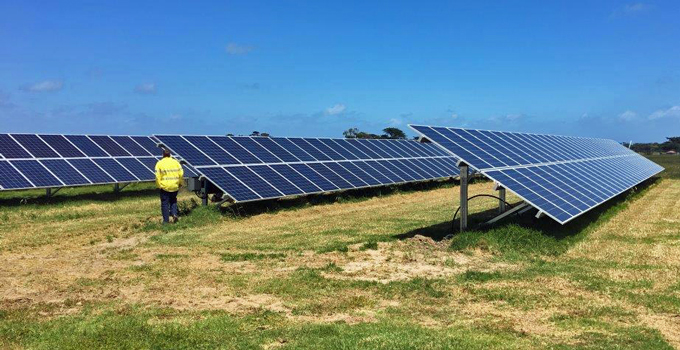
In this third part of our series of articles on overcoming potential roadblocks to solar developments, we take a closer look at how to navigate the planning environment for utility-scale solar PV energy projects.
Unlike domestic solar installations, which are often exempted from needing planning approval, larger utility-scale solar installations are likely to fall within the general planning requirements for renewable energy, which can significantly restrict the areas in which they can be considered.
The increased flexibility of the size and location of solar installations, and their ability to match the needs of users and supplement the capacity of the network, means that demand for solar is likely to rise in areas close to urban development. Solar installations servicing schools and universities, commercial development clusters or even specific neighbourhoods are set to become more attractive. The solar farm may become the new hobby farm.
However, due to the current constraints of planning systems in several Australian jurisdictions, renewable energy developments of this scale on many of these sites may be prohibited or dealt with inconsistently. Development control systems across Australia are generally not set up to facilitate development; rather, they control impacts. They are not proactive and lag behind the market, struggling to respond to rapidly emerging technologies and changing market demands. They can be frustrating to navigate and hard to change, which sometimes makes obtaining approvals hard work.
Is it easier to plan for a solar farm?
The planning system tends not to differentiate between various forms of renewable energy generation, constraining all forms due to the perception and experience of those forms with greater perceived impacts (such as wind farms).
Compared with wind farms, solar farms are less likely to encounter concerns about potential impacts on human health, visual amenity, birds and bats, or noise levels and have fewer physical constraints on location. Although solar developments are likely to have less visual impact than wind farms, this will still be an important issue to consider, as will glare and the area of ground coverage. High ground coverage means more potential impact on existing vegetation and less opportunity for complementary land uses.
While solar developments have more flexibility than some other forms of renewable generation to respond to, and avoid, local constraints, many of the important siting requirements are common to all renewable developments, such as the essentials of grid connection and construction access.
A particular consideration for large-scale solar developments is that large areas of flat land are often located in areas outside of council jurisdiction, which are state-owned and can be encumbered by existing leasing arrangements. More remote areas have greater potential to involve existing Native Title rights.
Solar developments have the potential to re-use degraded sites, such as mine sites which are no longer viable, and can complement the existing management and rehabilitation regime for these sites while also offering long-term energy solutions.
Navigating the planning requirements
The planning system is complex, and its potential impact on the cost, timeframe and overall success of your project should never be underestimated. Approvals for solar developments are not necessarily more complex than for other renewable energy developments, but some aspects will differ and the specifics of your particular project need to be taken into account.

As with all large-scale infrastructure development, comprehensive regulatory mapping at an early feasibility level is essential to understand what approvals are likely to be required and where any dependencies exist. Critical approval paths, roadblocks, timeframes and likely information requirements can be estimated and guide stakeholder discussion.
Depending on the scale, location and potential impacts of the project, approvals may be required at the Commonwealth level (through the operation of the Environmental Protection and Biodiversity Conservation Act 1999), the state level (through the implementation of state environmental protection legislation), and the local level (through the implementation of a local development control plan or planning scheme).
Once the approval requirements are confirmed, detailed technical studies are essential for clearly demonstrating that the issues are understood and that the development (and any mitigation or management measures) is appropriate and effective.
The application documentation should be targeted to match and address the requirements of the relevant development control document drawing on the conclusion of the technical studies. It should include both a summary of the proposal that identifies the key issues and mitigation measures, and the detailed technical studies which underpin the planning assessment.
When permits are issued, it is usual for there to be a number of conditions requiring further actions or additional documentation to be submitted. Planning for these requirements is essential, as noncompliance can result in action by the responsible authority or, in some cases, lapsing of the permit.
Ultimately, your best chance of planning success is through fully exploring and understanding the development control provisions, permits, consents and the level of assessment that are required, obtaining high-quality and comprehensive specialist studies, and keeping a watchful eye on any project-specific hurdles.
If you would like to find out more about how Entura can help you overcome planning roadblocks for your solar development, contact Silke Schwartz on +61 407 886 872 or Patrick Pease.
MORE THOUGHT LEADERSHIP ARTICLES
Portfolio risk assessment takes dam safety programs to the next level
A portfolio risk assessment allows owners of dams and other water assets to see the bigger picture of how to prioritise their efforts and resources to achieve the best safety result across their whole portfolio.
Constraints on budgets and resources remain key challenges for owners of dams and water assets, especially those with a large asset portfolio, as they attempt to reduce the risk to communities to an ‘as-low-as-reasonably-practicable’ level. Without a tool to prioritise safety works, it is impossible to use limited resources most effectively.
Dam owners have often overlooked the importance of prioritising their dam safety activities, resulting in resources being allocated equally to all dams or allocated randomly to selected dams.
For example, the traditional indexing method, which uses a standards-based deterministic approach to review deficiencies at a dam, does not look at the consequences of those deficiencies, so it fails to inform the dam owner of the associated dam safety risk.
Using a method such as this can often lead to defensive design, cost-ineffectiveness, blind upgrade, or a generic surveillance and monitoring program across all dams, and does not greatly assist the dam owner in managing the dam safety risk. Ultimately, resources may be wasted on low-risk dams, rather than used appropriately on dams with high safety risks.
Current best practice involves a risk-based probabilistic approach and takes into account the risk of failure of each dam to prioritise dam safety works. However, for a large dam portfolio, a full detailed risk assessment for all dams can be very costly and time consuming.
So, how can an owner of a portfolio of dam assets assess safety and prioritise investment without unnecessary effort or expense? The answer is portfolio risk assessment.
How portfolio risk assessment works
A portfolio risk assessment (PRA) is often a starting point for an effective dam safety program. It is not a detailed risk assessment of any particular dam, but an affordable high-level assessment at the portfolio level that presents to the dam owner the relative risk position of all dams. This enables the dam owner to better prioritise ongoing dam safety works and develop investment strategies.
In a PRA, the safety risk posed by each dam in the portfolio is usually assessed based on historically available information as well as information gathered in a workshop-type environment by an expert team of various disciplines. Key failure modes of each dam are identified, and the risks are quantified based on available information.
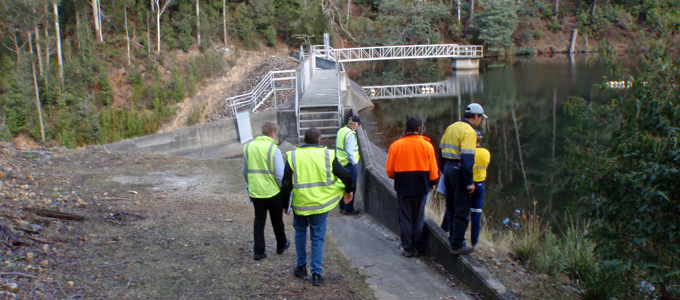
The key objective as a first step is to determine the first-pass risk position of the dams, followed by identifying any information gaps, strategy and priority to close these gaps. Output from a PRA can be tailored to suit organisational requirements, with risk positions determined in terms of societal, financial and political risks.
Flow-on benefits of the PRA process
PRA has proven to be a cost-effective tool in revolutionising an effective dam safety program for many dam owners in Australia and worldwide. It provides flow-on benefits to dam owners in managing their dam assets. In particular:
- Providing high-level focus and ease of reporting: A PRA provides an overview and high-level visibility and understanding of the current risk profile of the dam assets. This allows the dam owner to better focus on key dam safety issues, and makes reporting to senior management easier.
- Understanding relative risk and prioritising action: Establishing the risk profiles of all dams in a single risk plot not only informs whether the risk position of each dam is tolerable in accordance with industry best practice and guidelines, but also allows an understanding of the risk position of each dam relative to the others. This provides an opportunity for the high safety risk dams to be targeted first for dam safety activities, and allows prioritisation of dam safety recommendations.
- Best use of resources and identifying quick wins: Understanding the relevant dam safety risk profile provides clear direction for appropriately using resources to target mitigation of key risk items rather than attempting to implement all recommended actions at once, which is often not achievable. This also provides the opportunity to identify ‘quick win’ remedial works which may be less expensive yet significantly reduce risk.
- Ensuring key documentation is in place: Understanding the relevant safety risks of the dams also obliges the dam owner to ensure key documentation is in place, particularly for high safety risk dams. This may include dam safety emergency plans, operations and maintenance manuals, dam data books, hydraulic data, dam break inundation maps, and geotechnical reports.
- Reviewing surveillance and monitoring practices: A PRA provides an opportunity to review the existing dam surveillance and monitoring practice, and adopt a cost-effective risk-based approach to target the key failure modes rather than a blanket approach. As an example, a dam with a high risk of piping may require telemetered V-notches, whereas one without a high risk of piping may only require manually read V-notches or visual observations. In addition, the inspection frequency for dams with relatively low risk positions may be reduced, freeing up resources for use on dams with high safety risk.
- Improving dam safety emergency planning: An understanding of a dam’s key failure modes and failure consequences also allows improvement of critical dam safety information (e.g. event triggers, emergency evacuation), resulting in improved emergency planning.
Updating the PRA for continuous improvement
The outcome of a PRA would inform the knowledge gaps for any particular dams, and the necessary future works and investigations required to close those gaps. Following additional investigations, studies, remedial or upgrade works as a result of the initial PRA, it is good practice to update the PRA to review the portfolio risk and adjust the dam safety management strategy to achieve continuous improvement.
This will not only help dam owners to plan and prioritise their resources appropriately, but will also demonstrate to the regulator that an effective dam safety program is being implemented, which meets compliance requirements as well as industry best practices.
If you would like to discuss how Entura can assist you with assessing your dam risks through a portfolio risk assessment program, or apply the same PRA process to other key assets, please contact Shao Ng on +61 3 6245 4141 or Phillip Ellerton on +61 439 010 172.
About the authors
Shao Ng is a Senior Civil Engineer at Entura and has more than 16 years of experience in civil and dam engineering in Australia and overseas. Shao has considerable experience in project management, dam design and construction, geotechnical investigations, inspections and surveillance reviews, emergency planning, and dam operation and maintenance, and is familiar with national and international dam safety standards, guidelines and local regulatory requirements. Shao also has extensive experience in dam PRA.




